“We Do Journalism”
the Quadrangle
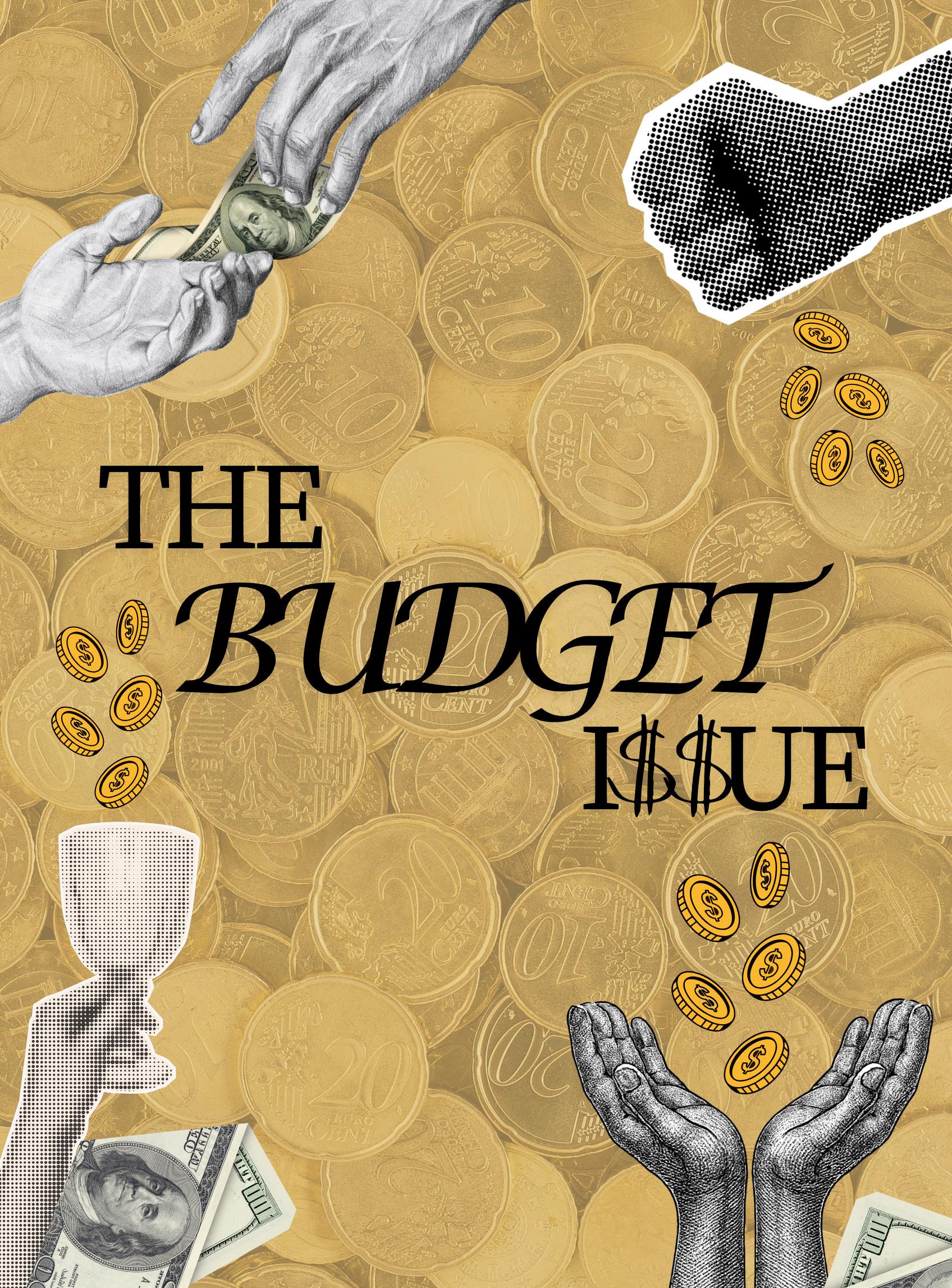
The Editorial Board
Grace Cardinal Editor-in-Chief
Emmanouel Sofillas Managing Editor
Laili Shahrestani Features Editor
Leyla Mercado Arts & Entertainment Editor
Barbara Vasquez
Maizy Swift Production Editors
Amy Forster Asst. Production Editor
Mary Haley Marketing Chair
Brooke Della Rocco News Editor
Mary Haley Asst. Features Editor
Andrew Mannion Sports Editor
Owen McWalters Asst. Sports Editor
Barbara Vasquez Web Editor
Maizy Swift
Elaina Batista Asst. Social Media Editors
Thom Gencarelli Faculty Advisor
About The Quadrangle

A tradition since 1924, The Quadrangle is a news organization run by the students of Manhattan University. We strive to cover news around campus and the greater community, publishing weekly in print and daily online. Our goal is always accuracy, relevancy and professionalism.
The opinions expressed in The Quadrangle are those of the individual writer and do not necessarily reflect the views of the Editorial Board, the University or the student body.
Join The Quadrangle
The Quadrangle’s staff holds weekly open meetings on Tuesdays at 4 p.m. All are welcome to come and join the club.
Connect with The Quadrangle




LETTER from the EDITOR
Dear Readers,
Hello, and welcome to The Budget Issue!
Our staff has been working tirelessly over the past few weeks to prepare this issue for you (in print!) and we couldn’t be more excited to share the final product with the campus community.
Before jumping in, a little bit of history: back in November of 2016, The Quadrangle published an issue similar to this one entitled “The Money Issue”. It explored many of the same themes you’ll find in these pages today – from evaluating the costs of higher education, the student debt crisis and student government budgets to the overall ways students are managing to get by in an increasingly expensive world.
While we try not to repeat themes, after extensive conversation our staff felt that it was time to revisit this topic through a different lens nearly a decade later. Considering both the COVID pandemic and the extreme budget cuts the university has faced over the past two years – plus what is now the longest government shutdown in U.S. history – conversations surrounding this topic feel more important and relevant than ever.
In this special issue, you’ll find stories about how students are shaping the future of finance, how Jaspers are surviving in one of the most expensive New York City economies we’ve seen in years and how cashless NYC is on the rise. Our writers also cover free student trips being sponsored by clubs, the success of performing arts amid low enrollment rates and the expansion of new club-level sports, along with much more.
On a personal note, this special issue holds a place close to my heart, as it marks not only the last print issue I will oversee in my time as editor-in-chief, but also the last I will work on as a Quadrangle staff member and Manhattan University student. I couldn’t be prouder to conclude the print part of my journalism journey on a high note, with an issue that our staff and I put so many hours into making as close to perfect as possible.
We can’t thank you all enough for your ongoing support of The Quadrangle and its mission to celebrate student journalism and the voices around our campus. Without further ado, The Quadrangle presents: The Budget Issue.
Until next time,
Editor-in-Chief
Invested:TheYoungandtheHowStudents FutureAreShapingthe ofFinance
Brooke Della Rocco News Editor
With a close-knit community on campus, Manhattan University’s finance program proves to continuously produce successful and entrepreneurially focused students into the finance world. Recently, a few of these students have been rising to the occasion, participating in internships with wellknown companies while also maintaining full-time or parttime student status.
For Ruby Jazwinski ‘25, choosing a future in finance was not a clear-cut decision.
“When I started college, I wasn’t sure what direction I wanted to take,” Jazwinski wrote in an email to The Quadrangle. “My sister had graduated with a finance degree and showed me all the possibilities that come with it. Once I decided to pursue finance, the professors at Manhattan College were so inspiring and supportive. They really confirmed that I made the right choice.”
Jazwinski has participated in a number of competitive internships with brands such as BronXchange and Tarte Cosmetics. She currently works at Internova Travel Group, beginning as an intern and ultimately turning the work into her full-time job.
“My most recent internship gave me exposure to nearly every role available within the finance industry,” Jazwinski wrote. “It helped me discover which path interested me the most and ultimately led to my full-time position there, which I’m so grateful for.”
Senior student Clay Pinkham has also shown dedication to his academics and work while at MU, with a double major in economics and finance in addition to an internship under his belt. Over
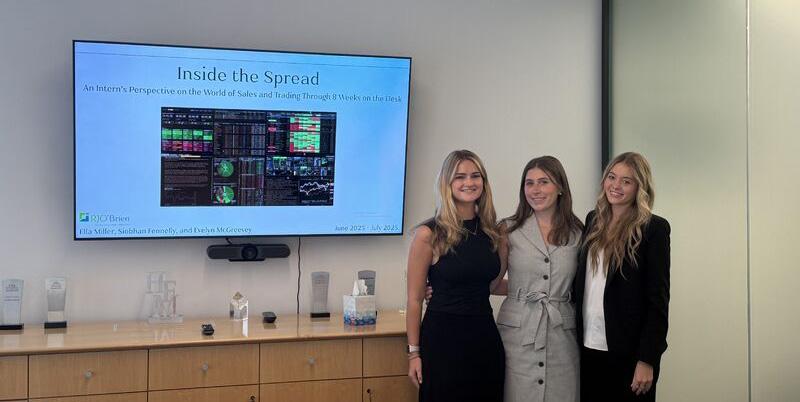
the course of the summer, Pinkham worked for First Citizens Bank as a corporate intern in the commercial services division.
“I had almost no expectations going in there,” Pinkham said. “By the end of the summer it made me realize, it was like a family…It made it better for me because it was like they welcomed me with open arms. It wasn’t like they were treating me like an employee…I mean honestly, everything just felt so friendly and open, like they wanted me to succeed.”
Pinkham hunkered down and focused on delving into financial statement analysis at the internship, which includes breaking out the company’s statements and understanding their capital structure. These financial statements are the core of multiple industries, and Pinkham was excited to fully immerse himself and hone these skills.
After being a part of the Manhattan University
Investment Fund throughout his entire college career, Pinkham rose to the portfolio head of economics position on the club board in his senior year. In this position, he focuses on leading the evaluation of macroeconomic risks across the portfolio and driving the transformation of the club’s investments.
“My task this year has been to give us a clean slate, liquidate everything and put us on the right track where our portfolio doesn’t have a high correlation between each other, which is what most portfolios aim to do,” Pinkham said. “Also just improve the club in terms of student retention, the trips we go on and the quality of the pitches that our students make.”
Similarly, senior Evelyn McGreevey works with the MU Investment Fund. McGreevey has also been involved in an immersive Sales & Trading internship
with RJ O’Brien, the oldest and largest independent futures brokerage and clearing firm in the United States.
“Most of our time was spent watching them and them teaching us, which I really loved,” McGreevey said. “Instead of having us do stupid work and pointless work, they were making the experience more important for us. We were benefiting more than they were and I just love that they prioritized us… It was a unique experience, because not only did I get the experience of the internship, but I got to see things, like acquisitions and how it [the company] is affected. It was just interesting.”
An honors finance student, McGreevey is actively involved in several finance-related clubs, including Beta Alpha Psi and the O’Malley School of Business Dean’s Student Advisory Council. McGreevey left the interview with a few words about the finance students at MU and their promise for a future in the job market.
“I would say a majority of the finance students are putting their all in while they’re here,” McGreevey said. “They’re getting any experience that they can, which is awesome, because Manhattan [University] gives a lot of experience. They’re just doing everything they can so that when they go into the field, they will be more than the average person entering the finance field.”

JaspersRedefineFinancial SurvivalinNewYorkCity
Laili Shahrestani Features Editor
New York City has been labeled as one of the most expensive cities in the world to live in for multiple years on end, resulting in affordability issues and financial struggles for many individuals. Manhattan University students remain one of the many communities of New Yorkers who feel impacted by the cost of living in the city, and are redefining what financial survival looks like to them through budgeting, sharing rent and working multiple jobs.
Leaving behind family and moving to college can be a struggle on its own, but
is oftentimes exemplified when finances come into the picture. Fiona Dunkel, a senior psychology major, spoke to this idea, emphasizing how becoming more financially independent, especially upon entering college, can be a struggle for many.
“I think a lot of people, once they get to college, may not have the same stability as they would living at home with a parent or a guardian,” Dunkel said. “And I think going to college, especially in the city, is going to be expensive. There’s not much to do that doesn’t involve spending money.”
To help combat this issue, Dunkel mentioned how she makes an effort to be mindful about how she spends her money, and implements budgeting tactics whenever
she can.
“I try to make little budgeting changes, such as making a coffee at home instead of buying coffee at a coffee shop on my way to class,” Dunkel said. “You know, even with late night snacking, especially after a night out, I try to have things at home that I can eat, such as leftovers.”
In addition to budgeting, many Jaspers share rent with one or more roommates as a means to make living in New York City more affordable, and work toward redefining financial survival.
Sam Wofford, a senior communication major, spoke about his personal experience with sharing rent with his two other roommates. He mentioned how by doing so while also actively budgeting,

he has been able to manage living in one of the world’s most expensive cities.
“I live in an off-campus apartment in the Waldo building, and have two roommates,” Wofford said. “We all share rent evenly, and our rent is $3,075, which is a $75 increase from last year. Separately, we all pay around $1,020…Living in the city can be overwhelming, but still manageable. Just listen to the basic ideas that your parents always tell you throughout high school about budgeting, such as trying to budget your groceries to maybe around $75 a week.”
Similar to Wofford, Brooklyn Schriver, a senior communication major, also made the decision to share rent with a number of roommates to help combat the prices of the city. She spoke about her housing arrangement, and how she has found it to be less expensive than living on-campus.
“I live in a house on Riverdale Avenue, and I have four roommates, two of them who are friends, and then the other two are people who go to this school, but I ended up meeting them through living together,” Schriver said. “I’ve been living there for two years now, and I like it a lot. You save a lot of money, compared to living on campus. We also have an inunit washer and dryer, which is really nice because that saves money too.”
Schriver emphasized how although she is saving money by sharing rent, she was still taken aback by the cost of living in New York City, moving to the city from Utah. She spoke about how she works several jobs as well as an internship as a way to manage expenses.
“Coming here as an out-ofstate student, I would say the biggest culture shock were the prices here, and how much everything costs,” Schriver said. “I definitely am going to be in debt for a long time. I take out loans, and I also work two jobs. I have an on-campus job, and then I also have my internship, so those help bring in income.”
Schriver briefly explained what types of jobs and side hustles she has taken part in over the past few years she has been living in New York City.
“I have a work-study job on campus, where I work in
the archives, and also have an internship with the New York Sports Club, which brings me a second income,” Schriver said. “I also do a little freelancing here and there, with videos and photos. Sometimes, I make graphics for people back home, or sell clothes on Depop.”
Isabela Sofis, a junior biology major, is managing expenses by having multiple businesses while still being a full-time college student. Sofis explained more about what led her to begin these businesses, and how they became what they are today.
“I have a sewing business, but then I also have a Depop business,” Sofis said. “I realized I just had way too much stuff, and I didn’t want to throw it all away, so I started selling it. And I’ve been sewing since I was 10 years old, so I’ve always known how to do it. My friends started asking me, ‘Oh, can you fix this?’ and they would also tell their friends, and all of a sudden people started coming to me asking to help fix or tailor their clothes.”
Similar to Schriver, Sofis is also an out-of-state student, who says that everything is much more expensive living in New York City.
“I’m from out of the state, so it’s extra expensive for me here,” Sofis said. “I mean here, you always need like three bucks to just get on the subway. It adds up, so I always need money.”
While New York City prices rank higher than most places, Schriver spoke about how it is still worth it for her to live in the city due to all the positive experiences and opportunities she’s had. She mentioned that living in the city takes hard work, but is rewarding in the end.
“In New York City, I think it is all about hustling if you want to live here,” Schriver said. “You have to go in with the mindset that it’s going to be expensive, but it’s a price you’re willing to pay to be in the city. Like, there’s so many different opportunities to make money, and also to meet people, network and further yourself career-wise.”
The Rise of Cashless NYC and Its Social Implications
Zeke Jazwinski Staff Writer
Over the last few years, New York City has been rapidly shifting away from the use of cash. Now, from delis to Michelin-star restaurants and even the MTA, more and more businesses are only accepting card and electronic phone payments. While using less cash can seem faster, safer and easier, it also raises questions about who can use it, how to keep things private and how to be fair.
For many people living in New York City, the limit on cash acceptance might mean limited access to essential needs. The Quadrangle spoke to a worker at Jasper Deli and two recent graduates from Manhattan University about how this shift has affected their lives.
“By far, we get more card payments than cash,” Hali Alhumaidi, a worker at Jasper Deli said. “As a business, we wouldn’t want to exclude any form of payment, even if most people pay with a card, phone or watch.”
Card readers and the use of Apple Pay have quickly become the norm. However, there is still an emphasis on the
accessibility businesses can provide by accepting multiple forms of payment. Alhumaidi also noted that card sales began to rise most sharply during the pandemic years and have continued to climb ever since, as digital payments have become more convenient than reaching into your wallet.
According to NYC.gov, “Stores must accept cash unless they have a machine to convert cash to a prepaid card.” This protection of cash has been heavily pushed for by lawmakers in New York to help ensure people who used cash all their lives don’t get lost in this new age of technology.
Two former students from Manhattan University discussed how simply using cards or phones to check out has changed their daily routines, from buying coffee between classes to splitting rent and bills.
Quinn Nagle ‘25 spoke of the positive and negative aspects of this shift.
“It’s definitely easier not having to carry cash around, but sometimes I feel like I’m losing track of how much I spend because everything’s just a tap away,” Nagle said.
The increasing shift away from cash is not just prevalent in NYC. As multiple cities become

behind the counter, where most customers now pay using cards or digital wallets rather than cash.
more reliant on technology, it changes the structure of public transportation.
The MTA’s OMNY system lets people use a phone, watch or card to ride the subway, inspiring the retirement of the long-held MetroCard, set for Dec. 31.
The rise of this use of technology will affect the older generations, those who don’t
ZEKE JAZWINSKI / THE QUADRANGLE
own Apple products and those reliant on paying for MetroCards with cash.
Corrinne Simeone ‘25 had a lot to say about the shift.
“It’s definitely made getting around quicker, but I can see how it’s harder for older people who aren’t as familiar with the technology,” Simeone said. “Not everyone grew up with phones or cards as their main way to pay,
so it can feel confusing or even discouraging for them.”
Whether it’s riding the subway, buying food or paying rent, the city’s growing use of card and phone payments reflects a change in time. It also means that New Yorkers, regardless of age or history, have to stay up to date with changes in New York life.

Features
ExploringtheCityOneFreeTripataTime
Maddie Rosado Staff Writer
In a city where every experience seems to come with a price tag, Manhattan University students are discovering that some of the best adventures are free. From wandering the grand halls of The Metropolitan Museum of Art with Sanctus Artem to exploring fashion history at the Museum at FIT with Lotus Magazine and even stepping onto the “Saturday Night Live” set with the MU Public Relations Student Society of America [PRSSA], student clubs and organizations are transforming New York City into their classroom. Through collaboration, determination and a bit of creativity, it’s students themselves who bring these trips to life.
Sanctus Artem, Latin for “pure arts,” is a student club dedicated to strengthening creativity and collaboration across the visual, performing and literary arts. By hosting workshops, events and cultural trips, the club gives students a space to express ideas and
connect with peers who share their passion for the arts.
Driving these initiatives forward is Lucas Haas, president of Sanctus Artem and a senior environmental studies major, who has played a key role in coordinating the club’s recent visit to The Met.
“We collaborated with the International Students Association for our trip to The Met,” Haas said. “We wanted to showcase The Met to those international students who are probably here for the first time in the city.”
Through the efforts of teamwork and consideration of participants’ diverse interests, Sanctus Artem was able to turn a simple museum visit into an engaging and educational experience.
“We had no funding for that trip, not that we really needed it in the first place… Luckily, most museums tend to be free in the city,” Haas said. “Behind the scenes, my E-board and I meet every week to discuss our plans for events. We came up with a list for RSVPs, and once we got that list, we sent everything out.”
While reflecting on his experience, Haas shared
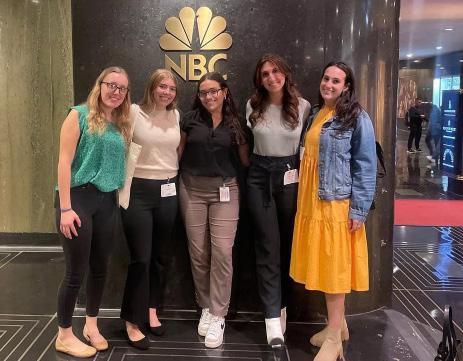
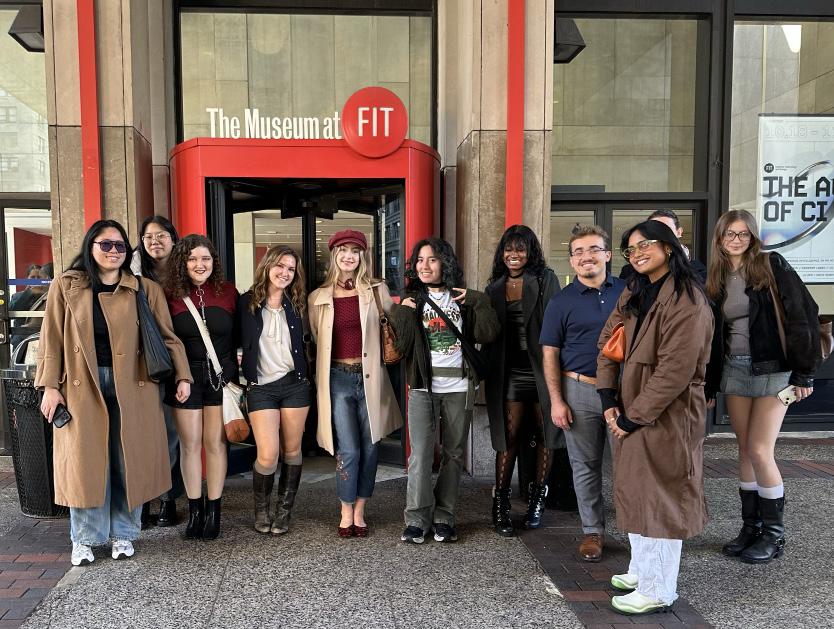
that he was thrilled with the outcome of the trip. Not only did it inspire him and his own passion for art, but it also sparked an appreciation for the arts among the students who attended.
“It was pretty inspiring to see how interested people were in art history,” Haas said. “Because art history is something that I am so passionate about, I definitely enjoyed seeing other students also enjoy the experience as well.”
After experiencing such a successful trip, Haas wanted more for Sanctus Artem. He and the rest of his team began researching other affordable cultural opportunities around the city, looking for new ways to engage members and expand their artistic experiences.
“We just wanted to find another museum to go to,” Haas said. “I never heard of the FIT Museum until we were doing some research. The museum is completely free for entry, no tickets required.”
Recognizing an opportunity for a collaboration, Haas invited Lotus Magazine, allowing the fashion-focused club members to join and enjoy the trip alongside Sanctus Artem.
“We knew that Lotus is a very big fashion-centered club on campus, and so we wanted to bring them along on this trip because I’m sure there are a lot of people from there who would be interested in joining us,” Haas said.
For Ivy Jaep, editor-in-chief of Lotus Magazine and senior marketing and global business major, the opportunity marked a new milestone.
“As editor-in-chief, this is the first time that we’re even doing a field trip,” Jaep said.
While Lotus Magazine has been reaching new heights as a club empowered by beauty, acceptance and advocacy, their dedication to hosting events and publishing issues has always relied on self-funding. For this reason, taking a club trip was something they had never imagined doing.
“We are self-funded… Sometimes it can be stressful, just because there is nothing coming in to help us other than what we put effort into,” Jaep said.
The idea of a collaboration with another club sparked possibility and excitement. Jaep and her team began considering how a field trip could fit into their plans, imagining a way to give members a unique experience without adding any cost.
“Lucas Haas, who is

the president of Sanctus Artem, came to me about this collaboration, and I didn’t know until I looked it up that the FIT Museum is actually free,” Jaep said.
A single trip quickly sparked bigger ideas, opening the door to future outings designed to enhance the club’s experiences and spark passion within current members.
“I’m hoping that we could go and do other trips like this, maybe even go to museums that aren’t free,” Jaep said. “I’d love to think of different things that can spark inspiration with our writers and our shoot directors.”
While reflecting on the club’s commitment to growth and creativity, Jaep emphasized the team’s dedication to pushing boundaries and providing meaningful opportunities for students.
“We’re always trying to do something more than we did the previous year,” Jaep said.
This spirit of student initiative and the pursuit of experiential learning extends beyond the arts, as other campus organizations such as PRSSA continue to find unique ways to provide students with hands-on opportunities in professional settings.
As one of the first clubs to offer affordable trips, PRSSA provided its members with opportunities that built on alumni connections in the arts and entertainment industries.
Leading these efforts was Mia Porritt, president of PRSSA and a senior communication major. Porritt spoke to The Quadrangle about a number
of the free excursions offered through PRSSA.
“We actually did a tour of NBC, and got to go see the “Saturday Night Live” set and some of their offices, which were really cool,” Porritt said. “We also went to Edelman PR, which was amazing because of how big their PR firm is… We actually were invited to along with other schools like NYU and Columbia, so that is another way we are able to take advantage of these trips.”
When it comes to the funding aspect behind each trip, PRSSA ran every excursion on a carefully managed budget, maximizing opportunities while still offering them at no cost to members.
“We have a budget of $200 a year, but all of our trips are free, and it’s purely based on alumni connections,” Porritt said.
For PRSSA, these trips are about more than just visiting iconic companies – they are carefully crafted opportunities for students to connect with real-world experiences. By utilizing alumni networks and the initiative of current members, the club creates accessible and professional learning experiences that inspire students to envision their own career paths.
“The biggest takeaway is really making sure that students realize that their dreams are achievable,” Porritt said. “It’s really good to see someone who is maybe in your class, or someone that you just saw in a leadership position on campus actually working in such esteemed roles.”
MU Students’ Tips and Tricks for Enjoying Free Time Without Breaking The Bank
/ Web Editor
College students typically carry around the stereotype of being “broke” and living as cheaply as possible to save money. Though students might take offense at being called broke, most would agree that having budget-friendly options for various food and activities is appreciated. While it may seem hard to imagine many low-cost options around Manhattan University, especially due to its location in New York City, some students shared their personal local gems with The Quadrangle that don’t break the bank.
Enjoying nature around the university does not have to be expensive. In fact, sometimes it doesn’t have to cost anything. Ty Jackson, junior communication major, spoke about Van Cortlandt Park being a good no-cost option for students to spend their free time.
“I mean, taking a walk through Van Cortlandt’s free, and I feel like that’s something that a lot of students should take advantage of,” Jackson said. “It’s a giant park and you can do basically whatever you want there. It’s great.”
Van Cortlandt Park, located right next to campus, is the third largest park in NYC,
hosting over one thousand acres of land. The park offers athletic facilities such as tennis courts, golf courses, skating rinks and more for the public to use for small fees. They also have barbecuing areas, hiking and running trails, play areas and even historical sites for visitors to utilize at no cost.
Jayden Peters, freshman video game design and production major and a member of the women’s golf team at MU, spends most of her free time using the park’s vast golf course.
“I mostly go to the golf course and back,” Peters said. “Van Cortlandt Park is very nice. The golf course is cheap. It’s public. They have most tee times open quite often, and the rest of the park’s free, so it’s nice.”
Outside of Van Cortlandt Park, MU’s bordering neighborhoods can provide scenic routes for students to walk along and enjoy. The weekly wellness walks held at MU, hosted by the kinesiology and health department, typically pass through these neighborhoods and give students an easy and budgetfriendly way to enjoy their free time. Senior psychology major Fiona Dunkel spoke to The Quadrangle about her appreciation for these walks.
“I’ve started doing the wellness walks on campus that I really enjoy,” Dunkel said.
“We get to go up to this little pond in the neighborhoods adjoining. Even just walking around Riverdale, it’s enjoyable and I don’t spend money doing it!”
Even though it can be fairly easy to find ways to enjoy time outside for little to no cost in NYC, the same usually can’t be said for finding cheap food. Like most college students however, Dunkel has a budgetfriendly favorite that she finds herself returning to.
“There is one place I found near Times Square called Ledo Pizza, where you can get a whole personal pie with a bunch of toppings for maybe $12,” Dunkel said. “It’s delicious, I just love going there. I haven’t been back in a while but I hope I can get there soon to get myself a little personal pie.”
Jackson shared some recommendations that were a little closer to campus.
“Last semester, I was living in a house with a few other guys on Irwin Avenue, and I’d say about every other week I would venture out to Teriyaki One right around the 237 Street plaza,” Jackson said. “They have a deal where you can get a chicken teriyaki combo with rice and a drink for something like $10. I loved it.”
By traveling further along Broadway, you can find Punto de Sabor Express, another restaurant that Jackson enjoys. He first found the spot using an

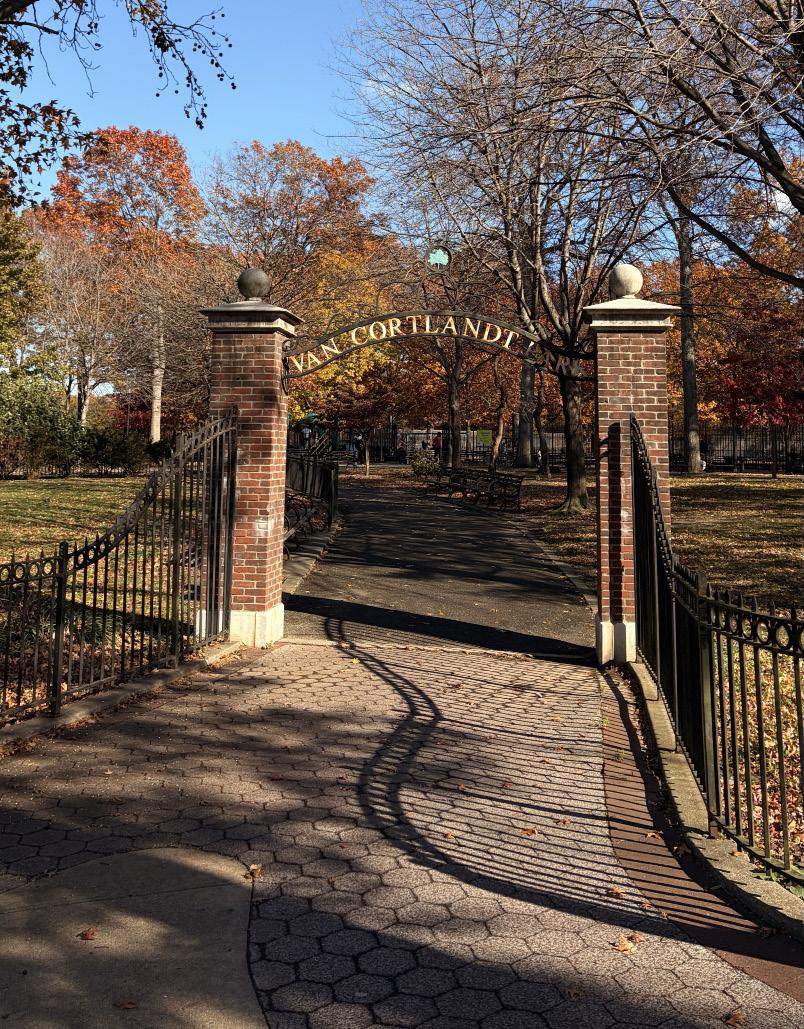
An entrance to Van Cortlandt Park, located at Van Cortlandt Park street and Broadway. BARBARA VASQUEZ / THE QUADRANGLE

Van Cortlandt Park, November 2025. BARBARA VASQUEZ / THE QUADRANGLE
app called TooGoodToGo, which allows restaurants to sell leftover food at a discounted price. TooGoodToGo was created with the initiative of reducing food waste, and has helped save over 400 million meals.
“I’d like to shout out my old astronomy professor because he introduced me to the app,” Jackson said. “The closest meal
you can get around here is on 231 and Broadway, right by the one train. You get like $15 worth of food for $5.”
Whether spending time at Van Cortlandt Park or finding good meal deals around the city, MU students prove that it’s possible to enjoy time at college without overspending.
ManhattanStudent-RunUniversity’s Clubs and Their Funding
Gabriella Dickson Staff Writer
At Manhattan University, most clubs are officially recognized and receive funding from the Student Government Association (SGA), while there are a handful of other clubs that are not officially recognized and receive no funding at all. Whether clubs are SGA funded or not, most host their own fundraisers to maximize student experience and the events they’re able to hold each semester.
Allyson Haskins, a junior communication and marketing double major, as well as campus coordinator of MU’s chapter of Her Campus, spoke to The Quadrangle about what it’s like to be a part of a studentrun organization at Manhattan University.
“It’s definitely a little bit stressful, but overall it’s really fun,” Haskins said. “It’s also really nice to see how everybody comes together from all different majors as well.”
Haskins mentioned that Her Campus was one of the clubs that did not receive any funding from SGA, and touched on how clubs such as her own may struggle to keep up with maintaining club standards.
“We actually didn’t receive
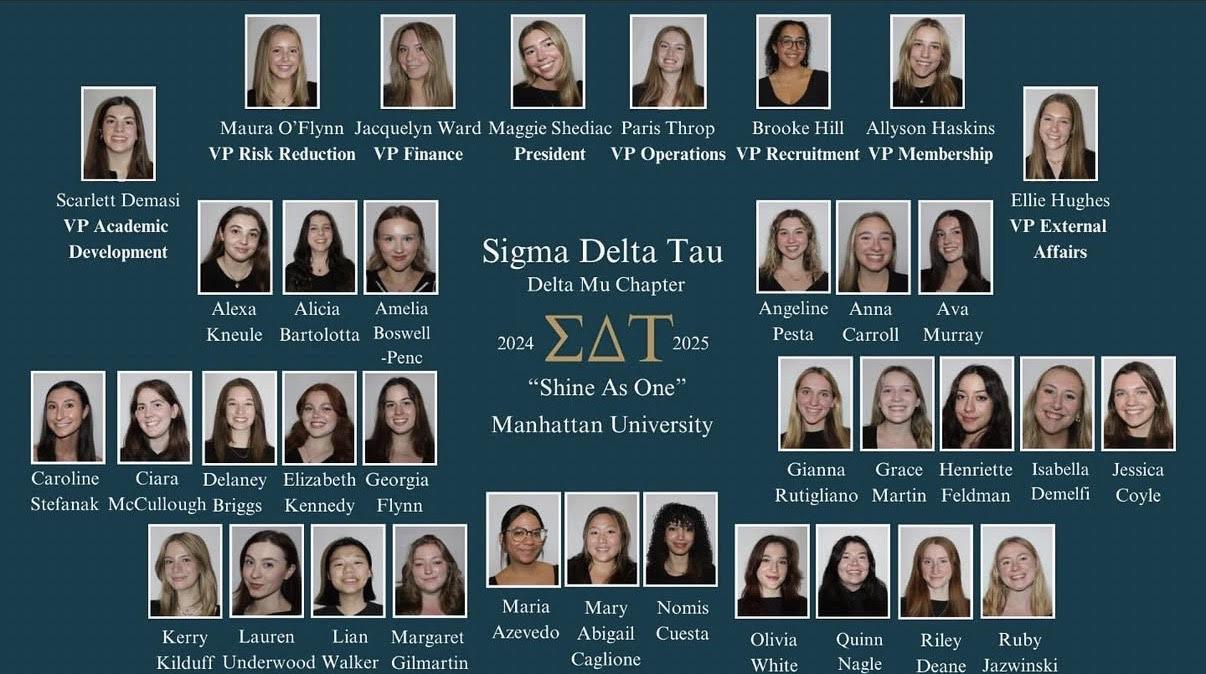
funding from the student government,” Haskins said.
“We used to in the past, but then we had gone dormant. We didn’t have a president until I took over again for a semester.
So we ended up losing funding, and now it’s been a struggle to get it back. But luckily since we’re a national organization, we do get opportunities to have free items for events and such.”
Lucas Haas, president of Sanctus Artem and a senior
environmental studies major, spoke to The Quadrangle about how funding is handled for his club, and how budgets have been tight recently.
“I guess they [student government] try to be as fair as possible, and like the other club leaders I talked to, it seems like we all have similar budgets for our respective clubs,” Haas said. “But I will say that all of our budgets are kind of tight on money. We have to
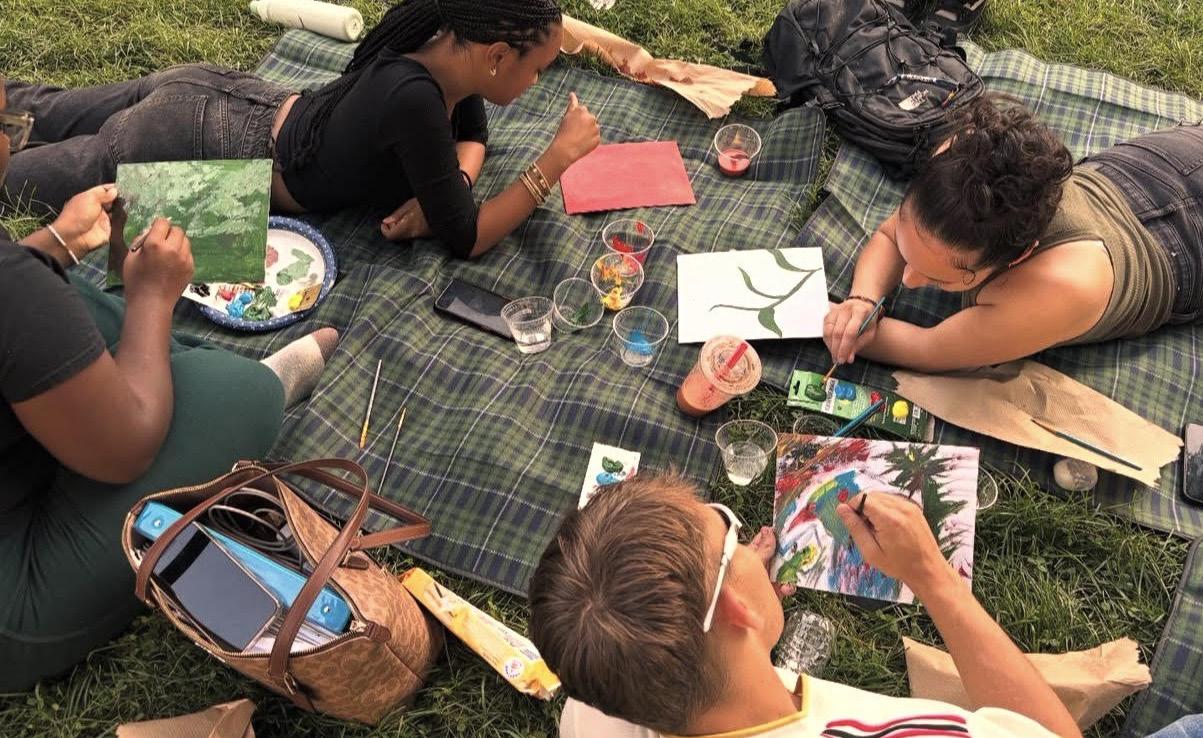
be real smart about stretching our dollars, to which I have been super creative with. Just keeping costs down definitely takes some creativity.”
Maggie Shediac, senior communication major and the president of Sigma Delta Tau (SDT), spoke to The Quadrangle about her experience being affiliated with a number of different clubs around campus.
“I honestly think that being in a club here is really, really rewarding,” Shediac said. “I’ve made a lot of my friends through the different clubs that I’m in on campus. I’m the president of Sigma Delta Tau, and I’m also involved in our Public Relations Student Society of America [PRSSA] club as well as Lotus Magazine, where I am an editor. I really enjoy it all, and I think it’s a great way to meet more people.”
Shediac also went on to speak about how SDT being a non-profit organization does not raise money for itself, but rather relies on the support of the university’s budget. She went on to explain how there are several events held throughout the year that are implemented to raise money for the sorority’s philanthropies.
“Well, because the sorority doesn’t do any fundraising for our club itself, we do
different fundraising events throughout the semester for our philanthropies,” Shediac said. “They’re called the Jewish Women’s International (JWI), and then also Prevent Child Abuse America (PCAA). Just a couple of weeks ago we also did a new member bake sale on the quad… but because we’re a nonprofit organization, we don’t raise money for ourselves, which is why the school’s budget that they give us is really important.”
While some clubs may receive funding and others do not, Haas made it a point to also raise awareness about the concept of funding for clubs here at MU, and how it is important to recognize that it is a necessary part for many student-run organizations to operate successfully.
“I would say funding awareness is super important,” Haas said. “Because it’s something that you’re a part of as a member of the club, and you may not think about it much, but money doesn’t just come out of nowhere. And so, it’s really important to focus on where clubs are going to be able to get this money from, and how they will be able to carry out all these activities for the members.”
The College Debt Cycle and the Future of Funding Higher Education
Misha Jabal-Abadi Staff Writer
Whether someone is an undergraduate or a graduate student, a common issue both share is the reality of student debt. Most who choose to get a college education will leave with debt that can potentially take years to pay off. Student debt can be caused by a number of factors, including rising tuition, housing costs, class materials and more.
Allyson Haskins, a junior marketing and communication double major as well as the vice president of student government, expressed that one of the biggest factors she’s noticed contributing to debt amongst her peers is the rising cost of housing and meal plans. She mentioned how this issue is leading more students to commute in hopes of reducing their debt.
“The cost of housing and meal plans is continuously going up,” Haskins said. “It’s cheaper to live off campus now, making our commuter numbers go up significantly.”
For active college students, student debt can significantly affect their day-to-day lives. Melinda Wilson, Ph.D., the director of the Center for Academic Success (CAS), shared that student debt is a contributor to the stress students feel every day. She emphasized that due to this debt, many students may not
be able to make the choices they would like to, including their desired job, as they may lean toward careers that will allow them to pay their debt off while earning a manageable income.
“I think it [student debt] impacts how able they [students] feel to kind of live life the way they’d like to,” Wilson said.
Haskins added onto this point, and described how this issue is impacting her on a personal level.
“As someone who pays for everything myself and incurs student debt, it definitely affects things I’m able to do and makes me want to enter a higher paying field,” Haskins said.
Wilson shared familiar concerns with this issue, as she mentioned there are similar patterns between her time as a student and the students she currently meets with. She mentioned how as a former student, every time she had to spend money on anything school-related, she had to consider the effects it could have in her future.
“When I was a student myself, student debt was something that weighed heavily on my mind every time I took out that credit card … ‘how is this going to impact what I’m able to kind of do in the coming weeks’,” Wilson said.
While students are struggling, Manhattan University is actively looking for ways to help with the financial burden of student

debt. The Jasper Guarantee was announced earlier this October, and will lock students’ tuition for the four years they attend MU.
Michael Mulrooney, the executive director of Jasper Central, spoke more about the Jasper Guarantee as well as how the university is working alongside donors and other outside resources to help in any way they can.
“We’re at lock tuition,” Mulrooney said. “With that in mind, to be able to control
costs and have a limit for students coming in, we’ve also tried to increase scholarship dollars by working with some generous donors as well as university funding to kind of mitigate that as well, but it impacts everybody’s decision a little bit differently.”
MU has also implemented income-share agreements (ISAs), which look at a student’s current income, and plan a payment course that works better for them according to that income. Mulrooney further explained what goes into this process, and

how it works.
“How income-share agreement works is that it looks at your income at the time, and you pay a percentage of that as your income increases and you pay back a little bit more toward the principal of your loan that you would have borrowed,” Mulrooney said. “And those are part of your exit loan strategies.”
Beyond ISAs and locked tuition, there are several other resources students can turn toward to help them with their financial situations. Currently, many students are using Sallie Mae scholarship awards, as well as applying to other outside scholarships they’re eligible for.
“I think a lot of students use Sallie Mae or outside scholarships,” Haskins said. “The university has pretty good financial aid, but it’s definitely decreased in recent years, making students struggle more – but the advisors are open for discussion and there to help.”
How MU’s Performing Arts Groups Have Managed to Stay Afloat Amid Budget Cuts
Similar to many other programs at Manhattan University, the performing arts program has faced many budget cuts since 2023. Despite this, the department has continued to maintain their steady events and performances each semester, supported by faculty, students and others who have donated to keep the arts at MU afloat.
Andrew Bauer, director of music and performing arts at MU, said that a positive attitude and efforts to maintain strong class and rehearsal experiences have helped not only to sustain the performing arts programs at MU but also attract more students to it.
“We’ve had to roll with the punches in terms of maintaining our program and advancing it too,” Bauer said. “But yes, our budgets were severely impacted over the last three years, although the overall enrollment at the school is down, the numbers in performing arts in every single one of our ensembles is up. It’s actually stronger than it was before all these budget cuts came in.”
The program hit the hardest in performing arts was the small group jazz combo,
which lost its director amidst the cuts. To keep the group going, alumni have been invited to rejoin and help the group with performances. However, without a director, the group is still being heavily impacted.
“We had to rely on the students who remained in the program to continue on their own, so the students didn’t stop rehearsing, they just are just doing it on their own,” Bauer said. “We also fill in the gaps by bringing in alumni who had been in the group before. The challenge for us is the students are only going to be able to do that for so long, and they’re not going to grow artistically and with their repertoire in the proper way they need. They need an experienced and seasoned director to do that. So I’m afraid that the small group will disappear if we don’t find a way of getting our funding back.”
As far as other programs, Bauer said the most important thing is maintaining a great classroom energy, which is a contributor to the growth in student numbers in performing arts.
“I insist that all of our directors create an environment in their ensembles that is conducive to camaraderie and a sense of belonging, a sense of unity, a sense of just having a good time working with each other,” Bauer said.
The growing numbers
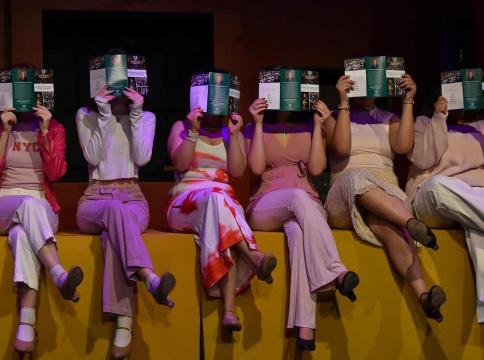
of performing arts students despite low enrollment at the university overall is not only a testament to how important performing arts is to MU, but provides further insight into the current student body, says Bauer.
“It speaks to the type of student that is interested in performing arts,” Bauer said. “I think those students tend to be more engaged in their lives, in the world in general, and this will spill over to their professional life because it’s going to make them more attractive to companies that they have something outside of their academic major that completes the whole person. Companies want to hire human beings, especially in today’s world with so much AI and robotics, we need to focus on our humanity.”
Kevin Cullen, a senior English major and theatre minor at MU, serves as production manager for the performing arts group Players. Cullen shared his experience during the first year of budget cuts to the program.
“What happened that year was the budget was so low that we weren’t even confident on having a large enough budget for our fall main stage,” Cullen said. “We had to do ‘A Comedy of Errors’, which is a Shakespeare play, and the reason we were looking for a show like that was because it’s public domain [so] you don’t have to pay anything for the show, so it went so far as to impact the shows that we even choose to put on.”
Cullen shared how despite the budget cuts, Players hopes to find ways to put on shows to the best of their ability by planning ahead and organizing for their performances. Cullen commented on how sometimes, hardships can make for more creative ideas.
“There is nothing that makes theater thrive more than limitation, if you’re able to do everything that you want, sometimes that works out really well, but a lot of really fantastic things can actually come out from having less budget,” Cullen said.

Olivia Bailey, a senior communication major and music minor, serves as producer for Players and shared her thoughts on the budget cuts and their impact on performing arts at MU.
“They [budget cuts] hit us hard because I think that performing arts is a pillar of the Manhattan University community, and when we don’t have the funds to make it as extravagant as we want to, it sometimes falls flat,” Bailey said. “So while our actors are extremely talented and I think that that’s what matters about theater, it’s just difficult.”
Bailey shared how despite the budget cuts Players has faced, students’ dedication to the performing arts program attests to what has kept the department going despite the difficulties.
“I think that the personal dedication and how much time and effort people put into
working on their music or working on themselves as a performer should really show people that the work we’re putting out is worth enjoying, it’s very good quality work,” Bailey said.
As for upcoming events such as the spring musical, Bailey said that this effort from cast members will help to make up for what the budget cannot.
“Unfortunately, with budget cuts, our two mainstage productions, which are directed by a professional director, are going to get most of the money,” Bailey said. “So the hard part for us is, with our student-run productions, coming up with the resources to put those on, so I’ve just been reiterating to people, if your performance is good, if you work on your craft, it really doesn’t matter if you’re in all black clothes in an all black room.”
MU Works to Promote Performing Arts Scholarship and Expand Interest in Digital Media Arts
Maria Castano Staff Writer
Following unprecedented budget cuts in recent years, Manhattan University has slowly been building itself back up, and looks to attract new students by marketing its resources, with an emphasis on scholarships, grants and cutting-edge technology.
Director of Performing Arts Andrew Bauer shared information regarding the performing arts scholarship with The Quadrangle, and spoke about how students are oftentimes uninformed about the scholarship’s existence.
“We have 12 [scholarship seats] for each class …They’re given out by audition,” Bauer said. “So if a student shows promise and talent, they’re awarded a scholarship, which they can keep all the way through their four years at the institution. We don’t fill up those 12 every year. Sometimes the students don’t know about the scholarships until after they arrive on campus in the fall. So in those cases, we do give out some additional scholarships if we have some left over… I think we have to do a better job as an institution about raising the profile of these scholarships to prospective students and their families so that they know about it, because every year I get quite a few students who tell me they would have auditioned for it if they had known about it.”
Bauer acknowledges that the performing arts department’s marketing to current and prospective students is lacking, however, this has not hindered enrollment in the Performing Arts ensembles.
“Enrollment at the university is down at this time, but the enrollment in the performing arts ensembles is actually up,” Bauer said. “Every single one of our performing arts ensembles has significantly more members than it did last year at the same time. So, I think we should market the performing
arts organization here at the school more because it attracts a particular type of student … The students that get involved with performing arts at the university level are the type of students that just are generally more engaged in the community.”
Manhattan University offers limited talent-based scholarships and grants which include the Performing Arts Scholarship, The Quadrangle Scholarship and Liberal Arts award. These limited opportunities and spots within them still doesn’t deter student interest.
“Our students [in the Performing Arts department] tend to not leave the school. They tend to stay here,” Bauer said. “Once they come in as freshmen, they stay the full four years, and they don’t transfer out [or] drop out. We have a very good, very strong record of maintaining our students here.”
Considering student interest and talent, MU has made efforts for students to put their expression to use. Crystal Benitez, coordinator of digital media technology, shared with The Quadrangle the efforts that have been made to showcase and facilitate students’ creative work both in and out of classes.
“We moved [to Miguel] over the summer, so we’re currently in 214,” Benitez said. “That’s one of our Digital Media Labs; we have two. They [students] have access to the labs as long as the buildings are open, which is almost 24 hours, [including weekends]. And then the sound and piano labs were also moved to Miguel, so that we have that section of the building now as a whole kind of creative corner. … We brought in the 3D printer so that the 3D modeling courses can now go into prototyping and making small sculptures. Right now, they’re working on wearables. For our animation courses, we use industry standard software, the same stuff that Disney Pixar uses.”
Benitez also shared with The Quadrangle the importance of representation at career fairs for people within
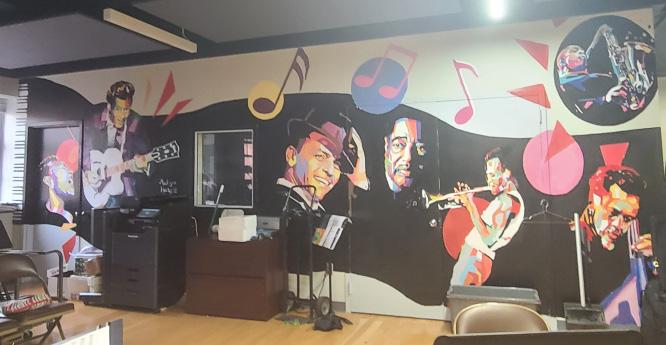
Mural in Thomas Hall 5.17.
MARIA CASTANO / THE QUADRANGLE
the creative arts.
“I think their career fairs don’t always offer things for students that are creative, but otherwise they do a good job with the clubs and creating an artistic environment,” Benitez said. “When I was an adjunct, students would tell me every year how the Job Fair just did not hit home for them, how it’s mostly architecture or business or engineering.”
Benitez further shared the plans the department has in motion to remediate this issue.
“This year, we actually did have a few art organizations involved [in the fair],” Benitez said. “I personally made sure that the BCA was part of the job fair. BCA is the Bronx Council of Arts, … they cater to Bronx artists, Bronx designers, photographers, cinematographers, writers, poets, journalists, anything in that realm. They actually had a few job openings at the current moment, so it was really good timing to get them involved at the job fair, but moving forward, I did have a conversation with the people that are in charge of the job fair, as well as the President, as well as the Dean … a few other faculty members, it became a very wide discussion, and it is understood that we do need more more art agencies, organizations, governmental [and] nonprofit organizations. It’s hard to get these entities
at job fairs, unfortunately, because of a lot of unwritten policies, unspoken rules that go along with these types of industries.”
Benitez highlighted the importance of student initiative when it comes to researching careers in the arts and encourages those interested in these industries to use faculty as resources.
“It’s one of my main priorities to make sure that everyone understands what’s out there,” Benitez said. “Before I was at Manhattan, I used to work at Arts Westchester, which is an Arts Council, and so they’re literally your information hub of where you get art grant funding, internships, and all types of resources for open calls and opportunities that artists would love to have the opportunity to access. We’ve been pushing grant kind of information, workshops, types of information we use the Moodle community sites a lot more so this semester than ever. But we’ve definitely been trying to make sure that the students understand that there are resources out there and that we are here to support [them]. One of the things I always kind of push forward is, if you have an idea, let me know, and if we can be part of getting that [idea] accomplished, then the more the merrier.”
Benitez also hopes to find ways to further display student
work.
“Soon, there will be a TV in Miguel that will also do this,” Benitez said. “So that we’re not only showcasing the digital works that are printed, but now we’re also showcasing animations [and] maybe some sound projects, or just digital media, like motion graphics and [the work from our] video course that makes some stellar videos. We’re also actually planning for next semester to have art being shown in the library. And this is something that we also used to do in the past. … So next semester will be our first time having student artwork shown there, and we plan for the first one to be a solo of a senior that will be graduating.”
Madison Hackett ‘25, a digital media arts graduate who painted the newly-unveiled mural in Miguel 5.17, also shared with The Quadrangle her outlook on how Manhattan University handles financial opportunities for students.
“The school is not always super clear on the funding issues,” Hackett said. “So as long as the school is more clear about what they intend to give us, I think that would be more helpful, but I would say there’s a lot of opportunities for students like me in the creative arts to show their talent and have fun with it.”
The Expansion of Club Sports at Manhattan University
Haley & Brooke Della Rocco Marketing Chair/Asst. Features Editor and News Editor
With the addition of new teams and an increase in student participation across campus, club sports at Manhattan University have expanded rapidly in recent years.
For many students, club sports offer a balance that Division I athletics sometimes cannot offer. Brian Astacio, a player on the university’s new club basketball team, described the experience as noticeably more competitive than intramurals, with a structure that better resembles an official game environment.
“Being part of the club sports team feels a lot different from intramurals, especially because it’s more competitive and I’m around people I don’t usually hang out with,” Astacio said. “It gives me a more realistic feeling of an under-thewhistle basketball game.”
However, the rapid growth of club teams has brought challenges. Scheduling remains one of the most common issues, especially for indoor sports that use Draddy Gymnasium, the campus’ sole basketball court.
“One of the biggest challenges we face in club basketball is getting consistent time and space in the gym,” Astacio said. “With so many [Division I] teams needing [Draddy Gymnasium], it’s tough for us to get the amount of practice time we really want.”
Funding also varies widely from team to team. Many newer clubs rely almost entirely on student dues and have not yet accessed sponsorships, fundraising or institutional budgets.
“Right now, we’re basically funding everything ourselves,” Astacio said. “The players had to pay out of pocket for jerseys and other resources.”
Not all teams face the

same constraints, however.
The Esports program receives direct funding from the university, which covers major expenses such as travel, equipment and jersey costs.
Esports team captain Dominick Recine, explained to The Quadrangle that their program has a designated budget from the school and small dues from players, and that while funding models differ across campus, Esports has not struggled to secure resources.
“All of our money comes from the school,” Recine said. “They fund us so we can get to wherever the venue is for championships.”
According to Recine, Esports also provides a structured environment similar to traditional athletics, with separate teams for different games such as Smash Bros., Valorant and Rocket League.
In previous years, the Esports team even traveled alongside MU’s men’s basketball team to their Metro Atlantic
Athletic Conference (MAAC) championships in Atlantic City to participate in tournaments held at the same venue.
Assistant Director of Recreation and Wellness Antoine Orr, who joined the college in September, said student interest in club sports was evident from his first meetings with club captains.
“This was a passion point for them,” Orr said. “They wanted guidance and support on how to do the little things right.”
Orr believes the appeal of club sports comes from offering students opportunities beyond the classroom.
“Students are passionate about what they like,” Orr said. “Club sports allow them to connect and build relationships with people they may not interact with academically.”
While the passion is present, finances continue to determine what each club can afford to do season-toseason. Orr explained to The Quadrangle that most teams
rely on dues, with an average cost between $100--$125 per player, though rowing has additional costs because of equipment and competition fees. Club sports like rowing, Esports and basketball currently receive university budgets in addition to dues. Those funds typically cover uniforms, travel, meals and lodging during competitions.
Teams that operate solely from dues can face concerns, especially when membership fluctuates by year.
“If a club only has dues and students drop out because they can’t pay, then the club has less money and fewer members, which affects what they can do,” Orr said. “So it becomes a trickle-down effect for the ones that have dues and budgets, it just affords them the opportunity to do things like travel.”
Some teams supplement with fundraising, such as flag football, which recently organized funding to compete
at the University of Maryland. Looking forward, financial planning depends on the broader affairs of the university. Orr said budget decisions are influenced by enrollment and overall college resources, which can change year to year.
“If enrollment increases, then there may be an opportunity to increase budgets,” Orr said.
As club sports continue to expand, students have begun proposing additional teams, including a return of club tennis and possible development of dodgeball. Orr touched on how student initiative remains the determining factor in the stability and formation of these clubs.
“If anyone comes in with a club idea, the question is whether they have the time and are committed to making it happen,” Orr said.
The Price MU Gear Holds for Jasper Pride
Zendrah Bonnick Staff Writer
Manhattan University merchandise is worn proudly on campus year-round by athletes and students alike. Whether an athlete is representing their team through apparel or students are sporting the latest shirt giveaway from basketball, apparel plays a large part in the campus community.
Eleanor Sak, a junior political science major at MU, discussed her perspective on the impact merchandise plays at popular school events like Manhattan Madness.
“School merch overall just helps students connect,” Sak said. “It brings a sense of community, especially in such a small school. We’re able to show that pride. Personally, I like wearing school merch. Madness is definitely one of the events every year where every student comes out, whether [they’re] commuter or residential. We all come collectively, wearing our school merch. It just shows the pride in the community that we have as a school, and we’re able to support both our men’s and women’s basketball teams in their journey for their season.”
Lucas Haas, a senior environmental studies major, shared his opinion of how merchandise shapes the atmosphere on the MU campus.
“I would say when you see people walking around campus

wearing the merch, it definitely enhances the school pride, it enhances that morale that people look for.”
Haas elaborated further, describing how the sense of school pride changes the general tone of the school. Additionally, he referenced the university’s financial uncertainties that arose in the previous few years.
“Since then [2023] the financial situation has improved,” Haas said. “I feel that it has improved this year.
I think it has improved the pride, especially having new students around.”
As a senior on campus, Haas has watched the feeling of school pride shift and change over the years.
“Last year, me and my senior friends, we were all there for all the Milo (Riverso) stuff, the former president, the budget cuts, and the firing of the tenure staff and all that,” Haas said. “That was kind of scarring for us, but the new

students kind of reinvigorated the school pride. The new class doesn’t really know too much about that, so it’s nice to bring school pride back, with a blank slate.”
Margret Groarke, Ph.D., a MU professor and the chairperson of history, political and international studies at the Kakos School of Arts and Sciences, spoke to The Quadrangle about how community building can be sustained even outside of the campus.
“I think around Manhattan, seeing sweatshirts and caps kind of connects people,” Groarke said. “Sometimes, you see people away from campus wearing Manhattan gear, and it is a point of connection with them…it is school spirit building.”
Aureliano Morales, a senior communication major, shared his thoughts on possible improvements for MU merchandise.
“There is potential in it,” Morales said. “Though I would
like to see new designs…But I would say pricing should be better, and also definitely do some of the designs because some of the designs are good, but then some are just lazy, just plastered on like the logo and all that.”
Morales later described how merch improvements could boost its popularity on campus. In addition, Morales shared details on his relationship with school pride as a member of this year’s senior class.
“I think we would see more people wearing it, for sure,” Morales said. “The Manhattan Madness shirts, or the ones for the basketball game, the ones that we got for Manhattan Madness, were really cool…Not [even] two years ago, people just did not want to wear merch as much. Now we’re at a better spot. We should be more prideful …There is a good opportunity, if it’s possible, for next semester to get a throwback to old designs and all that.”
“We Do Journalism”
the Quadrangle

MUKinesiologyCelebratesNational StressAwarenessDaywithPickleball
Studentstookabreakfromstudyinglastweektodestresswithfreepickleballoutsideof DraddyGymnasium.
@MANHATTANEDU/INSTAGRAM
MUDebutsNewClassic ReadingsSeries
Barbara Vasquez Production Editor & Web Editor
Manhattan University [MU] has recently unveiled a new “Classic Readings Series,” a “monthly celebration of literature and storytelling,” according to manhattan.edu. The series promises readings of various pieces of classic literature performed by MU faculty.
The idea for the videos came from Robert Cole, executive director of marketing at MU. Cole shared a statement with The Quadrangle about where this idea initially stemmed from.
“The idea is an offshoot of the Sixth Borough Film Festival,” Cole wrote. “The film festival is a testament to storytelling across multiple genres. The Classic Reading Series mirrors these same values and allows viewers to hear and see the written
Zohran Mamdani Wins NYC Mayoral Election pg. 17
words brought to life through the narration of the storyteller via the University’s web and social media platforms. By partnering with Dr. Michael Grabowski, Dr. Mark Pottinger and Kakos School of Arts and Sciences Dean Marcy Kelly, we were able to create a unique and creative way to promote literacy.”
The series premiered with a reading of “The Raven,” by Edgar Allen Poe, performed by Mark Pottinger, Ph.D. Pottinger, professor of music and musicology and chair of the communication, sound and media arts program, felt passionately about the combination of classic literature and performance.
“It’s great because it’s really about using faculty and various folks here on campus to reveal these classic tales, but at the same time connect us with these larger understandings of literature and how it has deeper connections, especially when
you hear it,” Pottinger said. “Words are not just to be written, and I think we lose focus by silently reading. These words were written like music on a score– not just to be analyzed on the score, but to be heard. There’s something very sonic about, not only poetry, but about literature in general that is supposed to be heard, not just something that is seen.”
The performance included a number of intricate details, all chosen with intention. The setting, located in the alumni room of the library, served as the foundation for the rest of the production to be built around.
Anna Schmidt, senior sound studies and communication double major, worked on the video’s production design and sound effects. She personally took care of some

MUTakes theSpotlight onAmazon Prime’s“The CollegeTour”
Manhattan University campus. He spoke about how he hopes the episode will bring more recognition to the institution and allow the public to gain more awareness of all it has to offer.
Amazon Prime’s original series “The College Tour” filmed an episode at Manhattan University last week, working to highlight not only what the university has to offer, but also allowing for a number of Jaspers around campus to have the opportunity to be featured in the production.
“The College Tour” is a television series aimed at visiting various university campuses and showcasing everything the institution brings to the table, from campus life and academics to student experiences and much more. The series incorporates student-led segments in hopes of giving viewers and prospective students alike a more accurate idea of what each university experience consists of, from a current student’s perspective.
The Quadrangle had the opportunity to speak with Alex Boylan, executive producer, host and founder of the series in regards to his inspiration behind creating the show.
“A little over five years ago, my niece was trying to figure out where to go to college… my sister gave her one trip to go take a look at college campuses,” Boylan said.
“Isabel, my niece, is like 99% of high school students that are out there, where her parents don’t have the money to go visit every single state and every single school.”
Boylan had many positive things to say about the
Players Hosts Annual Cabaret pg. 20
“Manhattan University is a phenomenal institution,” Boylan said. “We hear it all the time, ‘Oh my gosh. We’re a hidden gem.’ Well, we don’t want Manhattan University to be a hidden gem.”
For Boylan and his team, the mission was simple. They wanted to capture the authentic student experience and share the stories that make the campus so special. With many diverse student backgrounds and programs to choose, the most challenging part of production was deciding which stories to feature.
“There was an open casting call that went out months ago for students,” Boylan said. “We attack this like we attack any television or reality television show, where students are to put in their audition video.”
For Ioannis Rountos, a sophomore civil engineering major, the opportunity felt like a natural fit. As an admissions ambassador, he was already comfortable speaking on behalf of the university, so participating in the casting call felt incredibly natural.
“The admissions office was the one to originally let us know about this opportunity,” Rountos said. “Although it’s not part of our job specifically, they reached out because we’re used to being in front of cameras, not often, but enough, and talking about the school. So this felt almost second nature to us.”
CONTINUED ON PAGE 16
MU Club Basketball Begins Season pg. 23
The Editorial Board
Grace Cardinal Editor-in-Chief
Emmanouel Sofillas Managing Editor
Laili Shahrestani Features Editor
Leyla Mercado Arts & Entertainment Editor
Barbara Vasquez
Maizy Swift Production Editors
Amy Forster Asst. Production Editor
Mary Haley Marketing Chair
Brooke Della Rocco News Editor
Mary Haley Asst. Features Editor
Andrew Mannion Sports Editor
Owen McWalters Asst. Sports Editor
Barbara Vasquez Web Editor
Maizy Swift
Elaina Batista Asst. Social Media Editors
Thom Gencarelli Faculty Advisor
About The Quadrangle

A tradition since 1924, The Quadrangle is a news organization run by the students of Manhattan University. We strive to cover news around campus and the greater community, publishing weekly in print and daily online. Our goal is always accuracy, relevancy and professionalism.
The opinions expressed in The Quadrangle are those of the individual writer and do not necessarily reflect the views of the Editorial Board, the University or the student body.
Join The Quadrangle
The Quadrangle’s staff holds weekly open meetings on Tuesdays at 4 p.m. All are welcome to come and join the club.
Connect with The Quadrangle




LETTER from the EDITOR
Dear Readers,
Welcome to Issue 11!
In addition to The Budget Issue, we’re thrilled to bring you a regular issue this week as well! When in print…
While I’m sure you may have read my slightly sappy letter at the beginning of this double issue, let me once again take this white space to thank you all for your continued support. Seeing our work in print across campus is something that neither I nor The Quadrangle staff take for granted. To be able to have our presence physically seen on stands, in student hands and around classrooms is truly so rewarding, and serves as a reminder of why we do what we do.
I also want to take a moment to shout out our writers, editors and production team who worked tirelessly over the past few weeks – and all weekend – to bring this issue together. Special issues, especially double issues, are not an easy undertaking, and it’s in these weeks that everyone’s hands and hard work are on display even more so than usual. It is because of them and their dedication that The Quadrangle is able to tell the stories we do week-to-week, and I couldn’t be more grateful to lead the team as we do so.
As for this issue, we have plenty in store for you. In news, we cover Amazon Prime’s “The College Tour” filming on campus, MU’s new Classical Reading Series and a Manhattan Caucus following the finale of the mayoral election. In features, we cover the International Student Association’s coffee chats, as well as Her Campus’ “Fishy Affairs” event. In A&E, we talk all things Players and their Muppets cabaret, as well as Pipes and Drums and a Taylor Swift themed Jasper Jams. Lastly, in sports, we cover club basketball and bring you Games of the Week coverage. We hope you’ll take some time to check it all out!
As the semester winds down, we have two more issues ahead: Issue 12, which will publish next Tuesday, Nov. 18, and Issue 13, our final of the semester, which will publish following our Thanksgiving break on Dec. 2. Be sure to keep an eye out for both – not only will they contain news pertinent to the campus community as the semester winds down to a close, but news from me as I prepare to pass the torch onto the next editor-in-chief and staff who will be tasked with carrying our paper’s legacy forward through another successful academic year.
Until next time,
Grace Cardinal
Editor-in-Chief
CONTINUED FROM PAGE 14
Before filming could begin, Rountos had to prepare carefully for his on-camera appearance. This meant writing a script that captured his personal perspective and highlighted what he felt was most important about Manhattan University.
“It began with me having to write my own script, which, of course, had to be approved by both a representative from the school and one from ‘The College Tour,’” Rountos said. “But it was still my writing, and I got to talk about what I wanted to share.”
Writing the script was just the beginning of the process. Even with guidelines and approvals in place, Rountos
appreciated having the chance to share his story in his own words, giving a personal touch to the segment.
“A lot of things were done on the fly while filming certain segments, since things can look a bit different once you’re actually on set,” Rountos said. “They [Amazon Prime’s production team] were super flexible, creative and openminded with the types of shots they wanted to capture.”
Once filming began, the experience became more dynamic. Many scenes were adapted on the spot as the production team adjusted to lighting, angles and the natural flow of the campus environment.
“For one scene, we simulated a meeting between me and Nicole Brosnan, who runs student engagement,

which was something I didn’t expect but thought was really cool,” Rountos said.
Brosnan was brought in on the fly and expressed enthusiasm for the project.
“I just got pulled in right now, so I don’t know everything that they’re filming, but obviously, we have such an amazing campus,” Brosnan said. “We have lovely students, amazing professors, staff and administrators, so any way that we can highlight them, I’m sure it’s going to turn out amazing.”
Despite being brought in unexpectedly, Brosnan quickly adapted to the project and emphasized her admiration for how her everyday responsibilities were naturally integrated into the filming process.
“I think it’s really nice getting to showcase a conversation between myself and a student in a club because that is how I spend a good chunk of my day,” Brosnan said. “I love getting to interact with the students, so it meshed really nicely with my typical responsibilities.”
Brosnan’s reflections on her daily interactions with students highlight just one layer of the experience captured on the show. For Daren Woolsey, the show’s director and producer, the focus extends to the broader narrative.
“What actually is great about this show in particular is that, because we are telling
essentially different stories for students, here [at Manhattan University], we have five different students who are sharing their own personal stories,” Woolsey said.
Woolsey emphasized that the heart of the show lies in its ability to give each student a platform to share their unique experiences, and in return, filming the series gives him hope for future generations.
“I really appreciate and enjoy [my job], given the state of the world that we live in,” Woolsey said. “I’m seeing the quote-unquote future of our country working on this show, and it makes me feel good.”
By helping amplify the voices of students, the experience reinforced for
Woolsey just how meaningful his work is.
“More than anything, I’m just here to help support the students who have kind of put themselves out there to be a part of this, and to help them feel comfortable and supported through the process of telling their story,” Woolsey said.
To Rountos, that sentiment resonated deeply. Being part of “The College Tour” allowed him to experience firsthand the spirit of collaboration, growth and opportunity that makes Manhattan University truly exceptional.
“You get out tenfold what you put in, and I think that applies to life in general, but especially here, when you’re involved, opportunities just happen,” Rountos said.

MUDebutsNewClassicReadingsSeries
CONTINUED FROM PAGE 14
of the decor featured in the video, including a small raven skeleton placed in the background. Schmidt also helped evaluate optimal sound for the video, focusing on using sound in a way to best convey the message and tone of the original story.
“I think the acoustics of the room were really interesting because they were slightly reverberant, which I think helped add to this almost ghostly vibe,” Schmidt said. “I’ll also say Dr. Pottinger gave me chills. The way in which he was able to convey the story through his pacing of it, through the inflections and just his own vocal timbre… I feel like this version of it really brought it to life and gave it more emotion that is sometimes hard to get from reading it on a page.”
Schmidt became a part of the production after attending a class taught by Pottinger, where he extended an invitation for interested students to get involved. She
immediately took him up on the offer.
“I always love any chance I can get to do, I call it freelance-type work, where it’s more just pick-up stuff here and there,” Schmidt said. “I really, really love it, because it’s always such a unique experience. And this was obviously the first of a new series, so it was cool to be there for the development aspects.”
The team behind the video also included Michael Grabowski, Ph.D. Grabowski, professor of communication, sound and media arts, teaches multiple classes akin to the work done for the production of the video. For him, this project serves as a perfect teaching opportunity for students.
“I think that both for current students and potential students it’s a demonstration of what is possible,” Grabowski said. “It gives me the opportunity to show students what’s possible as far as setting up a recording like this. I’m using the same equipment that students use for their classes. The same
lights, the same cameras, and it just shows them what can really be done.”
As the series progresses, Grabowski hopes that more students can participate and help out with the videos.
“I’ve always told students that the best way to learn how to do production is to do production, and the best way to get better at it is to do more production,” Grabowski said. “With every shoot that you’re on and every shoot that you do, you learn some things and you get a little better at it. So being able to provide as many
opportunities as possible for students to get involved is really important.”
In terms of content, the series will not only focus on romantic style, like “The Raven,” but will instead highlight all different types of notable and fitting pieces of literature. No matter what choice pieces are chosen, however, they will all connect to the larger idea of the series.
“You want to get a real nugget of something that is complete and at the same time, something that hearkens this sense of connection
to a family of ideas that’s at the heart of a liberal education,” Pottinger said. “Ideas of thinking critically and knowing that what you see in front of you is not the whole picture. That there is a whole history and a whole understanding of things that go beyond the surface. I think that in the end, that’s what literature teaches us. By connecting ourselves [MU] with the series, we try to bring that forth and say that this is the type of environment that highlights that.”

Manhattan Caucus: Zohran Mamdani Wins New York City Mayoral Election
On Nov. 4, Zohran Mamdani, a democratic socialist, won the New York City Mayoral election, becoming the city’s first Muslim and person of South Asian descent to be elected mayor.
Mamdani won after running a campaign off a progressive platform focused on city affordability, frozen rent and universal health care among several other ideas. He became the first New York mayoral candidate to win over a million votes since the 1960s, and is set to take office fresh in the new year on Jan.1, 2026.
On Election night, Mamdani took the stage at the Brooklyn Paramount and delivered a victory speech saying, “The future is in our hands.”
He opened his victory speech with a quote from Eugene Debs, a socialist politician who had run for president in the early 1990s saying, “The sun may have set over our city this evening, but, as Eugene Debs once said, I can see the dawn of a better day for humanity.”
“In this moment of political darkness, New York will be the light,” he continued.
Mamdani then proceeded to use his time on the stage

to directly address President Donald Trump.
“Together, we will usher in a generation of change,”
Mamdani said. “And if we embrace this brave new course, rather than fleeing from it, we can respond to oligarchy and authoritarianism with the strength it fears, not the appeasement it craves…
So Donald Trump, since I know you’re watching, I have four words for you: Turn the volume up.”
Mamdani launched his mayoral campaign approximately one year ago, and in just 365 days has gone from being a relatively unknown assemblyman to the future mayor of America’s

largest city.
On Monday, just one day before the new mayor was elected, Trump threatened to restrict federal funds from New York if Mamdani won the city’s election.
“[It’s] highly unlikely that I will be contributing Federal Funds, other than the very minimum as required,” Trump said.
Also in Mamdani’s speech, he thanked several people including, bodega owners, “Mexican abuelas, Senegalese taxi drivers and Uzbek nurses, Trinidadian line cooks and Ethiopian aunties.”
“Thank you to the next generation of New Yorkers who refuse to accept that the promise of a better future was a relic of the past,” Mamdani said. “You showed that when politics speaks to you without condescension, we can usher in a new era of leadership.”
Mamdani’s election marks a
notable shift in New York City politics. As he enters office drawing attention to issues of affordability, healthcare and workers rights, critics question whether his proposals can actually be carried out effectively.
His path from state assemblyman to mayor highlights a demographic shift taking place in New York City, with his voter base coming from younger, working class voters.
Following his speech, Mamdani was joined on stage by his wife, Rama Duwaji, and his parents, filmmaker Mira Nair and Columbia University professor Mahmood Mamdani. The family embraced as fans shouted and confetti filled the Brooklyn Paramount, signaling the end of the campaign. As he waved to the audience, cries of “Mayor Mamdani” resonated throughout the auditorium.
International Student Association Hosts Immersive Coffee Chats to Create Community of Support
Grace Cardinal Editor-in-Chief
The International Student Association (ISA) has made bi-weekly coffee chats a practice this semester, holding one this past week focused on winter activities in NYC. These chats take place in the Campus Ministry and Social Action (CMSA) suite on campus, providing a space of comfort and conversation for international students.
Wednesday’s meeting saw students from Cambodia, Spain, the U.K. and even Long Island come together to discuss holiday traditions in the city, including the lighting of the tree at Rockefeller Center, ice skating at Bryant Park and New Years Eve in Times Square. The conversation soon diverged into students talking about holiday traditions from their own countries, and what they miss most when they’re in the states around these times of the year.
Senior and vice president of the ISA Cristina Pilon, a student from Barcelona, Spain, spoke to The Quadrangle about how last Wednesday’s theme was decided upon.
“There’s a bunch of things that happen in New York City [in] the season we’re in,” Pilon said. “We just see what things they [international students] can do in the city and [that] they might not know about, and try to do it. [Even] if we don’t have anything special to do, then we just try to do a Kahoot. This is just a funny way to get to know interesting facts about other places that we might not know, and it always creates more discussion after.”
Phol Neakarint “Rin” Keo, a sophomore finance and economics major from Phnom Penh, Cambodia, as well as the club’s treasurer, appreciates that the bi-weekly coffee chats
are an easy way to facilitate discussion and community for international students around campus.
“I found that people really enjoyed discussions with each other, casual talks, non-serious, colloquial talk,” Keo said. “The actual presentations [we do] are more for the functional purpose of the meeting, but people just enjoy talking about where they’re from, their different perspectives and just having fun, non-serious debates and discussions.”
Having only begun as a club in the spring semester, the ISA brought these coffee chats to campus for the first time in September, hoping to give international students a place to discuss their experiences with others going through the same thing.
“That was one of the things people bring up, is like, ‘Oh, I don’t know anybody that is like me,’ like international, so that’s why we implemented the coffee chats to, as I said before, create this community and space for people to get to know each other,” Pilon said.
However, the discussion space has evolved far beyond that.
Birdie Perry, a junior from Long Island, New York and the club’s secretary, joined the organization as an international studies major hoping to not only further her academia, but make her a better friend to the international students she regularly surrounds herself with.
“I’m usually the only American there, and it’s been really nice to learn so much about what it’s like to be an international student,” Perry told The Quadrangle. “And a lot of times we talk about how different things are to Americans and learning things that are considered “weird” in America that I never think about. It’s actually really fun. And my major is international
studies, so it’s kind of immersive into my field of study. I just love learning [about it].”
With the short five-day Thanksgiving holiday coming up, many international students aren’t able to make the trip back home to visit family, leaving them on a quiet campus over break. At times like these, Pilon explained, it’s extra important to have a feeling of community.
“Thanksgiving for most international people doesn’t mean anything, because we don’t celebrate it,” Pilon said. “But it’s weird because all your friends are going home and getting to see their families, and normally, you don’t have a place to go, and you’re staying on campus….I’m a senior, I’ve seen a bunch of exchange students come and go. I recommend them to try and go on a trip. Like, you don’t have class for five days, try to go to Florida, because it’s gonna get cold in New York. You are really gonna enjoy going there. Or try
to go somewhere around the country. And for international students that are here for the four years, I either say that, or I say maybe stay with a friend. [For] me personally, because I know finals are always around the corner, I just take this break for me, myself, and I. I go to the parade and enjoy it, and then I do my homework, do my essays, start studying for finals. So whatever you do is okay.”
Looking to the future, the ISA has no plans to stop hosting events.
“Next week, we’re doing a mindfulness Coffee Chat with the Counseling Center, so that will be the theme of that,” Perry said. “And our last event this semester will be a potluck with international alumni as well. That will be November 20, and so people are going to bring food from their cultures, and it’s gonna be a social gathering, interacting with alumni who were international students here too.”
An overwhelming message from the meeting is that everyone, no matter where they’re from, is welcome in the ISA.
“I feel like ISA is really important because being an international student, there’s a lot of struggles and a lot of paperwork and stuff you have to do that people who live here don’t even know about,” Perry said. “And I think that having the association to help each other out is a really good idea, especially when all the time visa statuses are changing. On top of that, I feel like the club is not just for international students. It’s also for domestic students to learn about international students, and make them feel at home and learn about other cultures, because it’s so great that we have this opportunity to interact with each other, even though we’re from all across the globe.”

Her Campus Holds “Fishy Affairs” Event Where Students Share Their FishiestStoriesDating
Zeke Jazwinski Staff Writer
Manhattan University’s chapter of Her Campus, the national women-centered media organization and gen-z magazine, hosted an event on Nov. 5 in Kelly Commons where attendees were able to share “fishy” dating stories, while also enjoying tuna snacks provided by Starkist.
Her Campus is not only a club, but a space for students to have a voice and let their creativity shine, allowing for individuals to express themselves and share some of their craziest dating stories in a non-judgemental environment.
The Quadrangle spoke with Allyson Haskins, junior communication and marketing double-major, as well as the campus coordinator for Her Campus, about the fishiest dating story she heard throughout the event.
“The fishiest dating story that we read today was about a girl getting asked out by a guy, and then later that same day, his wife reached out to her and let her know he has two kids,” Haskins said. “He was also texting eight girls at the same time.”
Fishy stories such as this one were found to be more common than one may think. Her Campus wanted this event to serve as a safe space, allowing people to feel free to share their stories and realize they are not alone – a goal that the group carries through the many events they host each semester. Beyond the laughs and gasps, these events help build a sense of community and openness on campus. They give students a chance to connect through shared experiences, empower one another and turn what might have once been an awkward or painful event into a moments of humor, solidarity and self-expression.
Camila Frias, junior English major and the assistant editor of Her Campus, spoke about how light-hearted events such as this one create safe environments, and can help people share their stories.
“I feel like these events give people an outlet to share their stories and to see that other people may have gone through the same thing,” Frias said.
Anna Macicolek, senior marketing and management major as well as senior editor for Her Campus spoke about what inspired the club to host

Students share laughs and dating stories during Her Campus’ “Fishy Affairs” event in Kelly Commons last week. GRACE CARDINAL / THE QUADRANGLE
an event such as this one.
“Her Campus was inspired to organize this event because we enjoy connecting with our community,” Maciolek said. “It was truly fun to hear other students and staff’s dating stories. It creates a sense of community through a relatable yet taboo topic.”
Beyond hosting lighthearted and relatable events,
the club does most of its work through its online magazine publication, where articles are published daily on topics ranging from pop culture and lifestyle, to campus news and even personal stories.
For the fishy dating event, the club’s E-board plans to take the stories that were anonymously shared and turn them into a TikTok for their social media
account, as well as an article that will go live on the Her Campus at Manhattan website. As for the leftover fish, the group plans to make a donation to the local Friendly Fridge.
For those interested in staying up to date with Her Campus’ future events and their students’ work, the group updates their Instagram @hercampusmu_ daily.

Players Turn IntoForMuppets Annual Cabaret
Mary Haley
Chair/Asst. Features Editor
Manhattan University Players kicked off another sing-songy semester with a cabaret unique to the school community: The Muppets Take Manhattan University.
Owen Sweeney, director of the cabaret, brought the Muppets to campus through nostalgic numbers like “Together Again,” “Movin’ Right Along,” “Man or Muppet” and “Rainbow Connection.”
According to the cabaret’s program handed out at the
beginning of the show, this was Sweeney’s first time directing in the Black Box, including some of the show’s set design, lighting and even writing the second act of the play’s script. He was described as being, “proud to be a member of such an outstanding club and to be leading such a talented cast in this production.”
Freshmen Sophia Whitmore and Natali Runles spoke to The Quadrangle about how this production marks their very first Players experience. Both came in as general members with ensemble roles, but quickly found themselves playing a
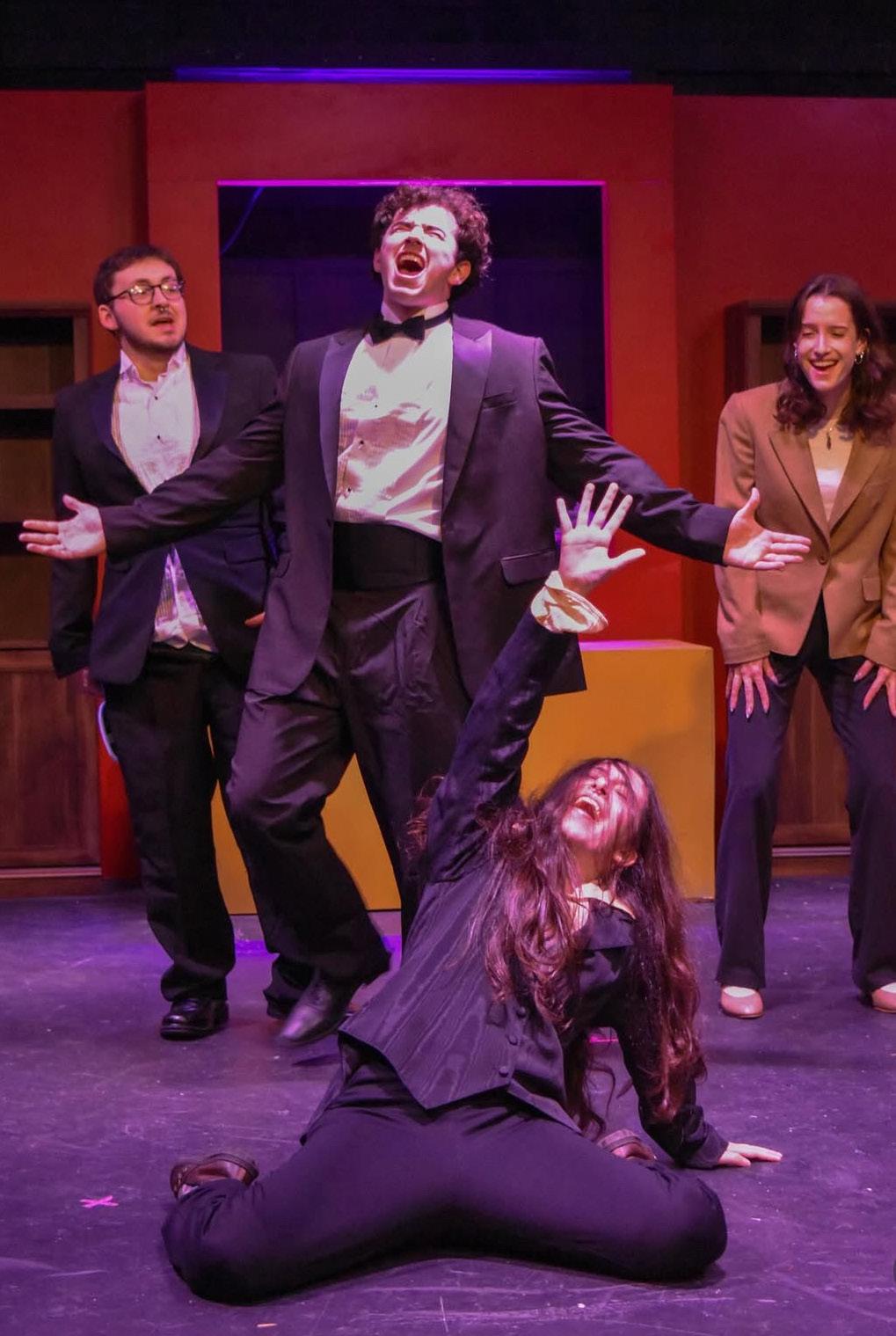
mix of characters including Miss Piggy, Scooter, Fozzie Bear, Electric Mayhem band members and even members of the Cratchit family.
There were no puppet suits in this cabaret. Instead, the cast relied on what Runles calls “Muppet-bounding,” a play on Disney-bounding: costumes built from colors and accessories to resemble characters without fully dressing as them.
“You can immediately tell who’s supposed to be Miss Piggy or Kermit,” Runles said. “It’s modern, but still very Muppets.”
Due to student-run Black Box shows and mainstage rehearsals overlapping, rehearsals for both productions were hard to schedule, with practices regularly stretched until midnight. Despite the late hours, rehearsals were a way for these new members to be introduced to what they can expect from the Players atmosphere.
“I was honestly just excited for the experience,” Runles said. “I know that the studentrun stuff is more low-key, which was a good introduction.”
The choreography was an important factor going into the execution of the story. Many cast members had to practice cartwheels, death drops and double left pirouettes that, for some, became one of the hardest challenges of the show.
“The whole show’s choreography is insane,” Whitmore said. “You’d think a student-run cabaret would be simple, but some numbers are full-on productions.”
Freshman political science major Lucas Long also made his Players debut through the cabaret. He had an extensive background in theater before college, although he had never done a cabaret previously. In the show, Long played multiple characters, including Fozzie Bear, Dr. Bunsen, and the
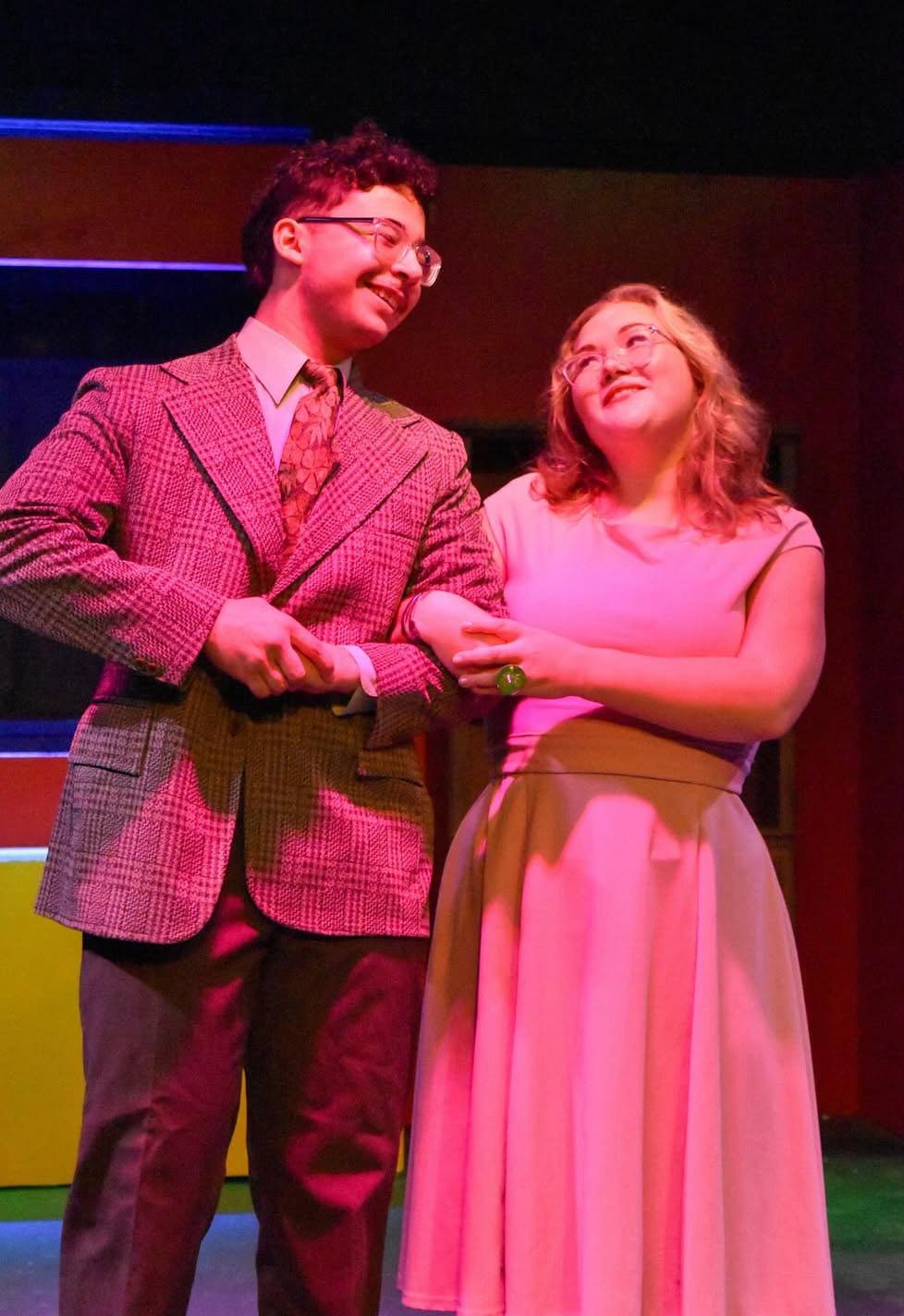
Players “muppet-bounded,” using colors and different articles of clothing instead of full costume to resemble muppets.
SADIE FOX PHOTOGRAPHY / COURTESY
cloaked Ghost of Christmas Present. For him, the biggest challenge was adjusting to the Black Box, where the audience surrounds the performers on almost all sides.
“In theater, you’re taught to always face the audience,” Long said. “But when the audience is everywhere, you have to retrain your brain. There is no front.”
Long says that Players was one of the main reasons he chose MU. He wanted a theater community that wasn’t overly competitive, but still
passionate, creative and fun. After working on the Muppets cabaret, he said the experience confirmed he made the right choice.
“I think I just love that the creative direction was just, ‘yeah, we’re Muppets, but we’re also just people and let’s not do overkill with this,’” Long said. “It’s the same thing with the set with how we’re in the Black Box, which is not a traditional theater. So it’s like, this is what we have to do with the set to make it work.”
Manhattan University’s Pipes and Drums Picks Up Momentum Heading Into Busy SeasonSpring
Zendrah Bonnick Staff Writer
The Manhattan University Pipes and Drums has played a role in the MU performing arts community since 1981. Over the years, the awardwinning band has participated in St Patrick’s Day parades, the Roseland Ballroom in New York City and various other events. With their practices picking up momentum as they head into the spring season, The Quadrangle sat down with members to talk about the importance of the club.
Brendan Keane ‘25, a civil engineering graduate, commented on the club and on his position as snare drum sergeant.
“The band is a great club to join if you are Irish or not,” Keane wrote in an email to The Quadrangle. “I had no drumming experience and was able to march down 5th Avenue on St. Patrick’s Day. We practice on Thursday nights at 7:30 pm in Smith Auditorium. Anyone is welcome to come by to learn more about the band.”
Keane further elaborated on what personally led him to be interested in the club.
“I was drawn to the band to continue my Irish culture,” Keane wrote. “I also have a brother who learned to play the bagpipes.”
Areg Varzhapetyan, a sophomore electrical engineering major and member of the club, discussed the cultural and historical significance of the program.
“Pipe and drum music is rooted in Scottish and Irish history,” Varzhapetyan said. “Bagpipes in particular are more or less the national instrument of Scotland, and share popularity in Ireland,
playing a major part in military and folk music tradition for centuries…With the arrival of Scottish and Irish immigrants to America came the spread of that tradition, especially in New York City, where many of these immigrants settled. Manhattan University shares in that musical culture mainly because of its large demographic of students with Irish and Scottish heritage.”
Varzhapetyan also discussed the role that Pipes and Drums plays in community building at MU.
“I think people should know that the Manhattan University Pipes & Drums is not only a band, but also a community of its own,” Varzhapetyan said. “There are both students and alumni in the band, who come together one night out of the week to chat and hang out, and have some fun playing music. There are people who show up to practice who don’t even play in the band, but just come to hang out. Everyone knows everyone, and it’s almost like a family.”
New members without previous experience are welcome to join the organization. Varzhapetyan mentioned that the group even has a tutoring program built in to train those who are new to the instrument.
“It is quite difficult to find anyone with experience, especially on bagpipes,” Varzhapetyan said. “However, no experience is required. We recruit people with no experience every year. Although learning either pipes or drums is hard, we have tutors to teach newbies, and by St. Patrick’s Day in March, people can already play enough to join us on parade.”
Varzhapetyan said that the once-a-week group practice,
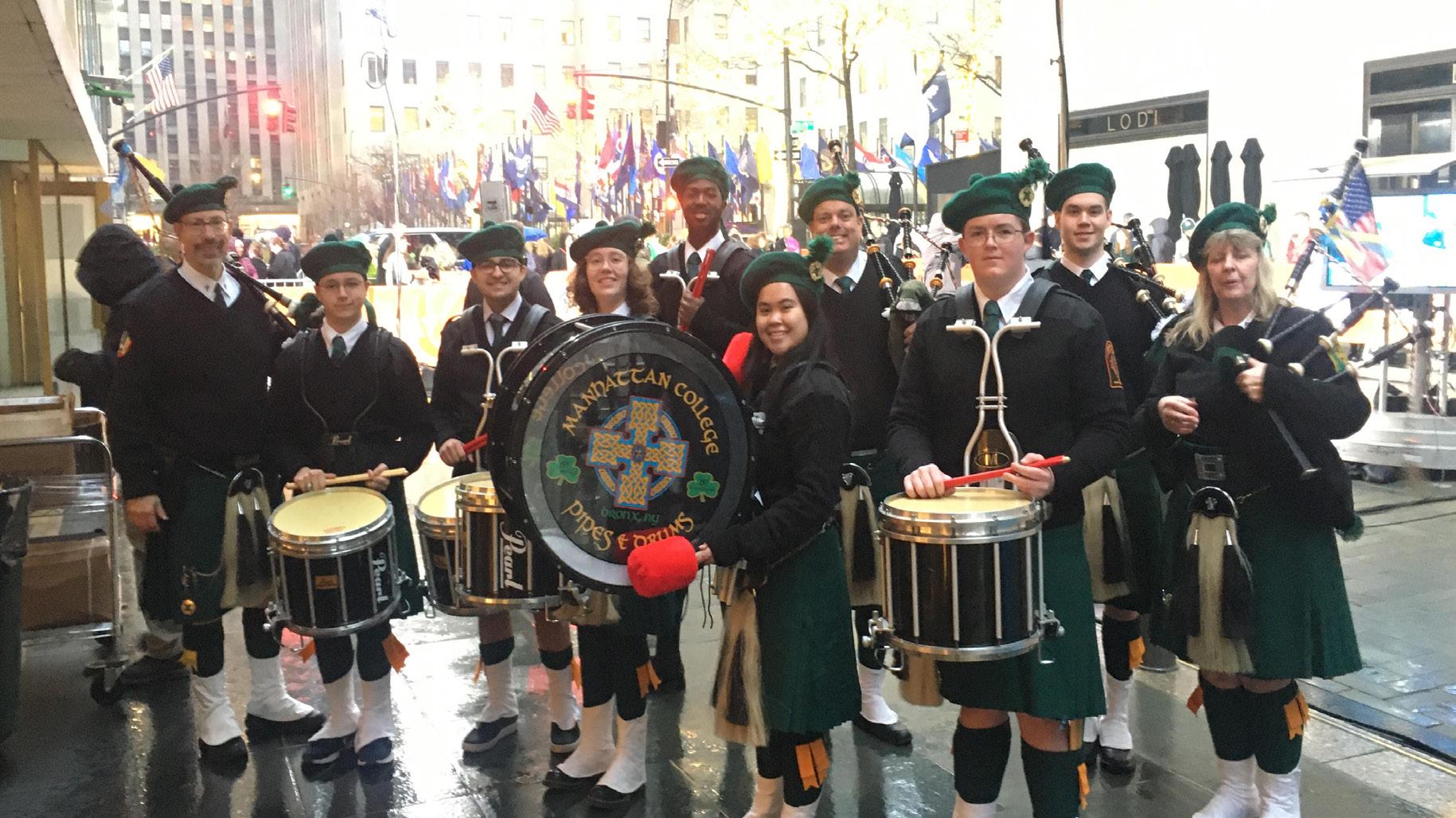
along with some personal practice, isn’t too demanding, and that even ten minutes a day can make a difference.
John Howard ‘24, ‘25, majored in accounting at MU and graduated with his MBA in May. He commented about his perspective as a former club member.
“Growing up either attending or participating in St. Patrick’s Day parades made me really interested in the pipe band, and when I found out Manhattan had its own, I decided to give it a try,”
Howard told The Quadrangle.
“I grew up playing Irish music, specifically the accordion and tin whistle. While I was familiar with some of the tunes, learning the bagpipes without prior experience was very rewarding…Being able to march in one of the many parades we do is a wonderful feeling that more people should experience. We have a motto of ‘no experience needed’ and we stick by it and teach you from the beginning.”

Jasper Jams: Death of a Showgirl?
Joshua Reichard Staff Writer
“The Life of a Showgirl”, Taylor Swift’s 12th studio album, was released on Oct. 3, and immediately, it was heavily criticized online. Clips of negative opinions, reaction to “cringe lyrics” and overall annoyance with the album flooded social media. However, diehard fans of Swift came to the artist’s defense, saying that she could “do no wrong” and refused to be critical of her work. I’ve decided to approach this album somewhere in between those two positions. Even though I’m a fan, I’m not unable to criticize and I understand why people have issues with much of the album.
The main criticism people shared of this album is that it’s too childish. People think the lyrics are too simple, joking that she wrote it this way so her fiance, Travis Kelce, could understand it. People found many of the album’s lyrics to be “cringe” and not thoughtful. This is an interesting switch up from her last album, “The Tortured Poets Department”, where people complained that it was too long, too complex
and that the average listener couldn’t understand it. Now, she’s done a 180 degree turn, and people still aren’t happy. To them, it seems, her new album is not long enough, not complex enough and boring.
My opinion is that “The Life of a Showgirl” is not perfect. It’s not as concise as I would have liked. It feels choppy and off-theme at points, and even has a song or two that are unlistenable to me. However, Taylor Swift doesn’t have to make everyone happy. She doesn’t have to be a bastion of taste and excellence in music. She can be playful, experiment with new things and even be a little cringe. Many times, her surface-level, playful songs are some of her best. Before forming an opinion, I encourage you to listen to the album. I’ve listed some of my favorite songs from the album below, and after listening to them, you might even add one or two to your fall playlist.
Opalite
Opalite is a fun, upbeat song. It has everything you can ask for from a Taylor Swift pop song. It has a catchy hook, and is easy to dance to. Swift has explained that this song
is about needing to create your own happiness to be truly happy, and I think that is a fitting description of its contents.
Favorite lyric: I had a bad habit / Of missing lovers past / My brother used to call it / “Eating out of the trash”
Honey Honey is easy to listen to. This song is quick and catchy. I can’t help but smile when I hear it come on. Swift sings about being called “Honey” in a genuine way, as opposed to in a degrading way. Nobody likes being talked down to, and now there’s an anthem that can relate to that feeling.
Favorite lyrics: If anyone called me “Honey” / It was standing in the bathroom, white teeth / They were saying that skirt don’t fit me / And I cried the whole way home
Ruin The Friendship
A classic, quieter Taylor Swift song, “Ruin The Friendship”, is about wishing we said something to someone when we had the chance. In this song, Swift sings about a high school friend who she had a crush on but never did
anything about. Her friend later passed away, and she reflects on what she wished she did.
Favorite lyrics: My advice is always ruin the friendship / Better that than regret it for all time
Elizabeth Taylor
Elizabeth Taylor feels like a song off of Swift’s 2017 album, “Reputation”. It starts off quiet, then has a punchy chorus that is hard to ignore. It’s playful, but feels mature. The song is a nod to the 20th century actress of the same name, who Swift compares herself to. They both faced heavy scrutiny throughout their years in the spotlight.
Favorite lyric: Be my NY when hollywood hates me / You’re only as hot as your last hit baby
CANCELLED!
This is one of the most heavily criticized songs on this album for a certain “cringe” lyric, but I can’t help but laugh. That’s exactly what this song is about – Swift not caring about what her haters are trying to cancel her for. This song is fun and witty. It feels like a return to Taylor’s younger self,
not musically, but through its attitude. Taylor can never be good enough, neither can her friends, and that’s just the way she likes it.
Favorite lyric: Can’t you see my infamy loves company? / Now they’ve broken you like they’ve broken me / But a shattered glass is a lot more sharp
The Fate of Ophelia
The lead single of the album, this song is a hit. Swift sings about how her fiance brought her up out of her sadness, and metaphorically “saved her heart” from the fate of Ophelia, Shakespeare’s character from Hamlet who dies from drowning after many tragic events occur. I also suggest watching the music video that accompanies this song, as it is a fun watch.
Favorite lyric: And if you’d never come for me / I might’ve drowned in the melancholy / I swore my loyalty to me, myself, and I / Right before you lit my sky up
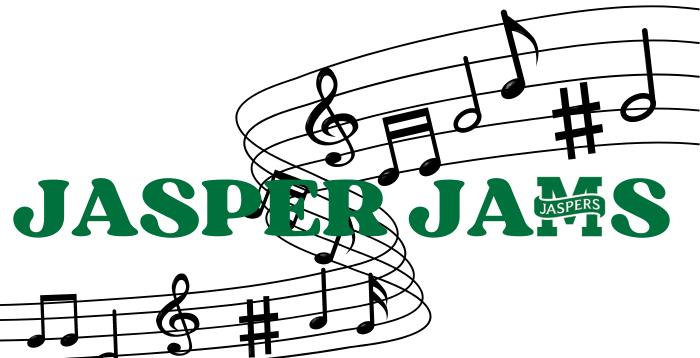
Manhattan University’s Club Basketball Targets Regionals in First Season
Emmanouel Sofillas Managing Editor
Manhattan University is launching a men’s club basketball team with goals of early wins, stronger chemistry and a higher profile. In their first season, the team already has its eyes set on regional competition.
“Our main goal this season is to go undefeated, build strong chemistry and represent Manhattan University every time we play,” Tyler Dunn said.
Players set a postseason appearance as the first-year benchmark.
“Success for the team this year is making it to regionals,” Dunn said. “It’s our first season as a program, and that’s the tournament we’re aiming for.”
Chayce Taylor described the season as a foundation-setting effort focused on cohesion and steady improvement.
“To build chemistry as a team and set the tone overall for what this program can be,” Taylor said. “I think we have a lot of talent, so it’s important that we learn how to put it together…Seeing the growth as a group — our effort and teamwork improves each game.”
Charles Kirote emphasized that culture and togetherness will weigh alongside results, noting urgency in his final season with the club.
“I would define team success not just through the wins but how we come together as a team and build chemistry on and off the court,” Kirote said. “My main goals this season are to grow closer with these guys. And being that this will be my only season with the club basketball team, I want to win and keep on winning.”
Rain Ricafort linked team development with personal scoring ambitions and a target for cohesion by spring.
“My main goals for this first season together as a team is to give my best effort in helping this team develop into an allaround threat and to be one of the leading scorers,” Ricafort said. “Finishing the season as a fully developed team where everyone is able to play off each other well and our team
chemistry is up to par.”
Taylor outlined postseason aspirations beyond a regional berth.
“We’re shooting for stars and aiming for the moon,” Taylor said. “We hope to make a deep postseason run and compete for a national title.”
The team isn’t discounting their regular season goals, though. Ricafort commented on hopes for an undefeated season prior to heading off to regionals.
“I would definitely love for our team to go undefeated in the regular season since we are already at a disadvantage due to the start of our season starting later than others,” Ricafort said.
Kirote kept the focus narrow to immediate results, saying that he’s looking to put one foot in front of the other and take the season one game and win at a time.
Dunn spoke to the fact that early practices have stressed energy and support.
“The team has come together great during practice,” Dunn said. “We uplift each other in everything we do, and even if someone messes up, we’re there for each other and keep the energy positive.”
So far, Taylor says, sessions have centered on learning tendencies and system buy-in.
“We’ve been pushing each other a lot as a team,” Taylor said. “The energy is good and everyone’s learning each other’s style of play as well as buying into our system.”
The primary hurdle the team has been running into thus far is with conditioning.
“The only real challenge has been conditioning,” Dunn said. “But that’s something we can get through easily as long as we keep practicing and putting in the work.”
The team has also been working to schedule practices not only around team members’ personal schedules, but the free-time in Draddy Gymnasium, which is the same court used by the DI teams. Kirote said that players are supplementing with individual work because of this.
“Really just finding set times to practice, but we all find time to get our own work in, whether that be hoops or a proper workout in the gym,”

Kirote said.
Ricafort discussed the same point, focusing on limited facility access and efficient practices when the team is able to schedule time inside the gym.
“We haven’t been able to have consistent practice times during each week due to Draddy being occupied almost every day, but when we are able to have practice we put in efficient work,” Ricafort said.
Taylor said role definition remains fluid, as the team’s roster is diverse.
“A lot of our guys are older so it means they haven’t played organized basketball in quite a while, so we’re just learning how to be one well-powered machine,” Taylor said.
Dunn said returning to structured play and team bonds motivated his decision to join. “What inspired me to join the team was wanting to play basketball under the whistle again and be part of a team,” Dunn said. “I wanted to build bonds and grow with my teammates.”
Astacio said he is seeking competitive wins with friends and a transition from streetball to organized play.
“I just wanted to win some games with my friends and keep getting better,” Astacio
said. “I also wanted to see how my streetball skills translate into organized basketball.”
As for Taylor, being a part of the team allows him to further represent MU while reigniting his passion for the sport.
“For me it’s the love of the game and the chance to represent my school, while doing something I’m extremely passionate about,” Taylor said.
The creation of a level between intramurals and DI made the move to the club team an easy choice for many on the team, including Kirote.
“The previous three years here at Manhattan, I’ve done intramural basketball,” Kirote said. “So when I found out we were making the switch to club I was naturally excited and jumped at the opportunity to play.”
Ricafort said he missed high school and AAU competition and wanted a comparable college challenge.
“I joined the basketball team because I missed the competitiveness of high school basketball and AAU basketball,” Ricafort said. “I wanted to experience a similar amount of competitiveness in college as well.”
Members of the team are looking to set personal goals this season as well, centered
around development and trust.
“Individually, I hope to grow as a player and as a teammate,” Dunn said. “As a team, I just want us to keep getting closer because teams with great chemistry and trust in each other always go far.”
Astacio tied his season goals to leadership while aiming to deepen team bonds.
“Individually, I want to become more of a leader and keep learning the game,” Astacio said. “As a team, I want us to reach our full potential and even go past that. I want us to become more than just teammates — more like brothers.”
Taylor said he is targeting smarter, more consistent play and long-term program building.
“I hope to use this opportunity to become a college basketball player in the future,” Taylor said. “Separately I hope to become a smarter and more consistent player … and to just build a solid foundation for the program I’ll be a part of in the coming years.”
As for Kirote, he’s focused on leadership development that will extend beyond the sport and weekly practices on the court.
Games of the Week
Women’s Basketball
The women’s basketball team played its home opener game of the season on Monday, Nov. 3, losing 52-38 to the Rhode Island Rams at Draddy Gymnasium.
The game started slow, with both teams employing strong defense to keep the score low. Colette Mulderig helped to keep Manhattan close with a couple of early layups, but Rhode Island pulled ahead with a late run to end the first quarter.
In the second quarter, Manhattan continued fighting, with Kristina Juric opening the scoring in the paint, followed by key baskets from Brianna Davis and Ishuana Hunter. Despite their efforts to keep the game within reach, Rhode Island extended its lead to 20 points by halftime.
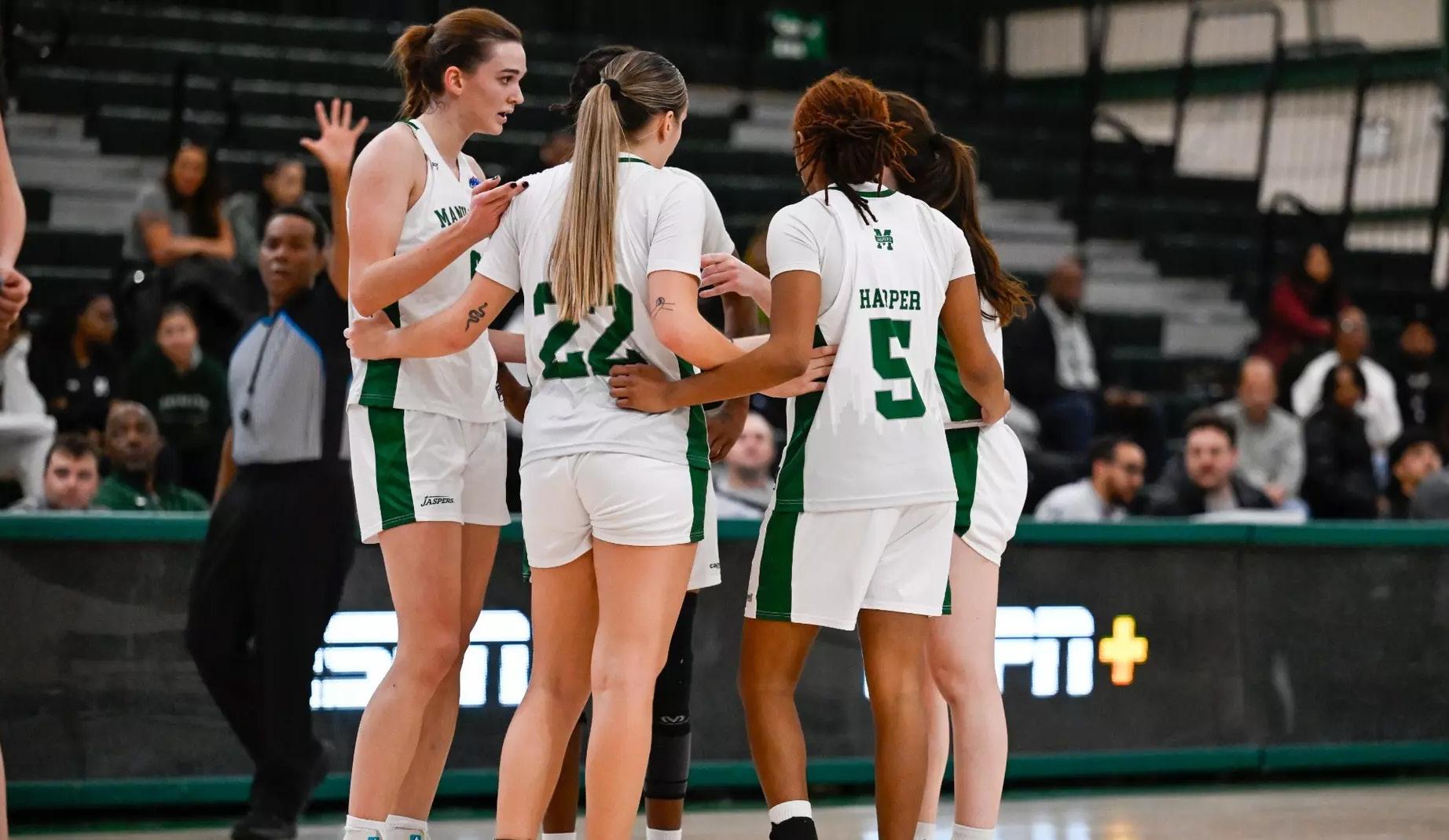
The third quarter was a turning point for the Jaspers, who scored 17 points in the frame, including 11 points from the free-throw line. Davis and Hana Mühl helped the team gain back its momentum. By the fourth quarter, Manhattan tried to keep the energy going, and Davis continued scoring, maintaining the pace. Rhode Island kept the game strong, knocking down key shots and holding on to the lead.
Despite the strong lead from Rhode Island, Manhattan
kept going, and the Rams responded every time. Ishauna Hunter scored the final points for Manhattan, but the Jaspers were unable to get back into the lead, which ended the night with 52-38 score and 0-1
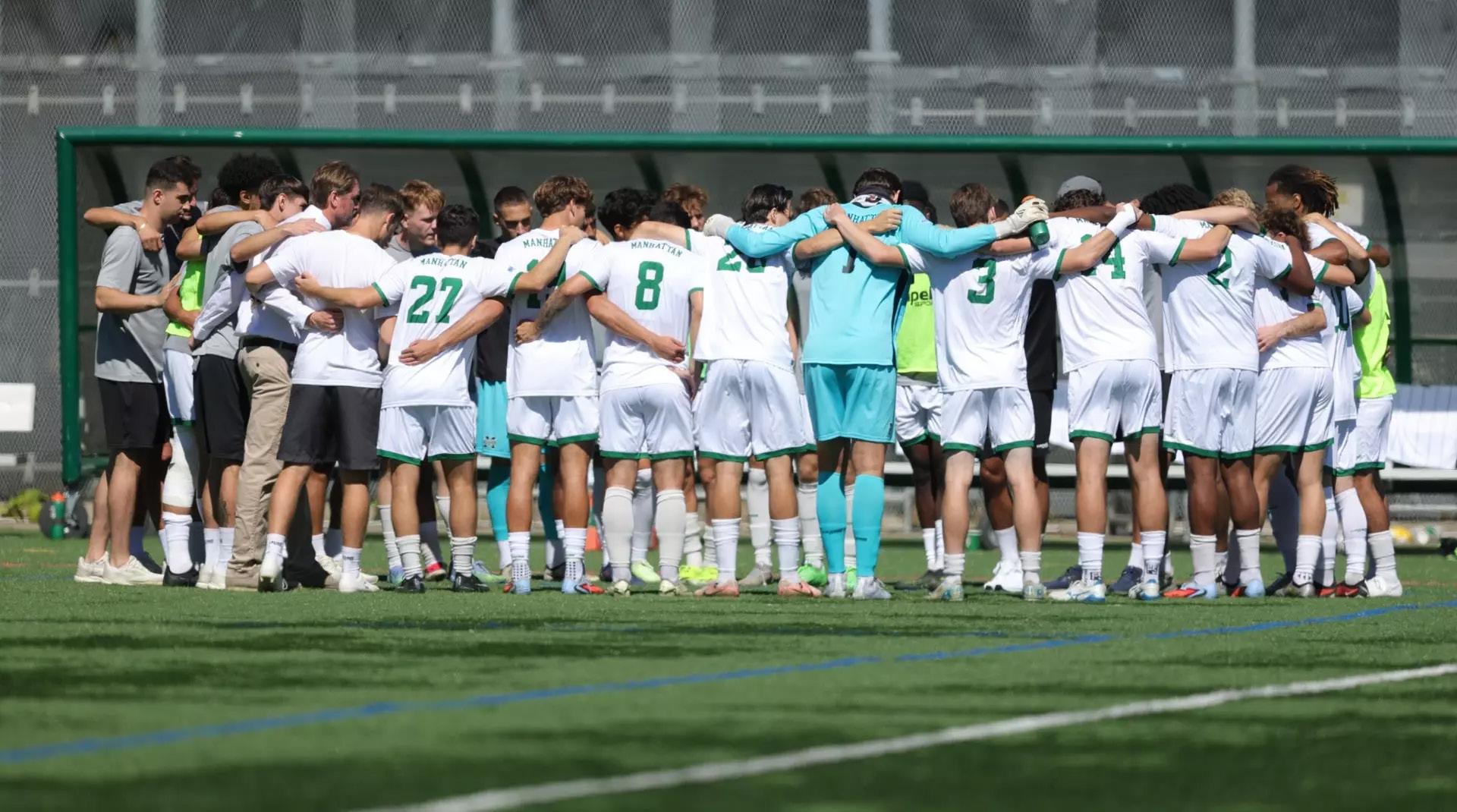
record to start the season.
Senior guard Davis led the team with 18 points on five for 12 shooting, marking the second-highest scoring total of her Jasper career. Mulderig had seven points with two field goals and three points from the stripe. Eleven of the Jaspers’ 17 thirdquarter points came at the freethrow line, contributing to their 17-4 run in the period.
Men’s Soccer
The Manhattan men’s soccer team closed out its MAAC season on Wednesday, falling 3-1 to Iona at Gaelic Park.
The match opened with heavy pressure from the Gaels, who took several shots early in the first 11 minutes into the game, but couldn’t break through right away. After 30 minutes of backand-forth play, Iona finally scored the first goal in the 32nd minute of the game.
In the second half, Manhattan came out with energy, creating several scoring opportunities.
However, Iona responded quickly, doubling their lead before the Jaspers could score. Manhattan midfielder Jason Araujo netted his first collegiate goal with an impressive strike roughly 35 yards out. Physical play intensified on both sides, resulting in multiple yellow cards.
In the 78th minute, Paul Abbatiello pushed the pace but it was unsuccessful, and Ibrahima Keita followed with another attempt but also fell short. The Gaels managed to transition and score a late goal that sealed their 3-1 victory.
Araujo finished the game with two shots and one target across 64 minutes of action off the bench. Redshirt junior defender Abbatiello recorded a match-high four shots with two on goal in 90 minutes on the pitch.
